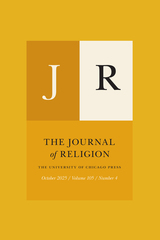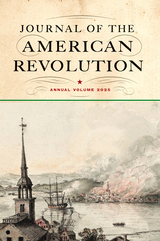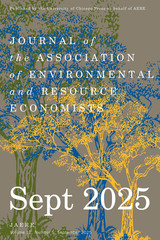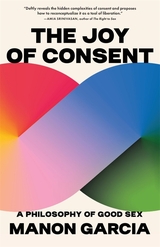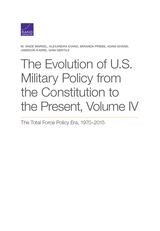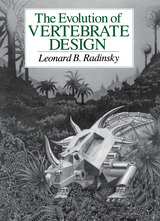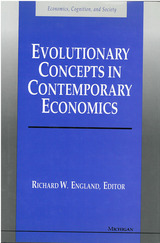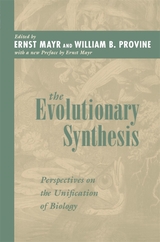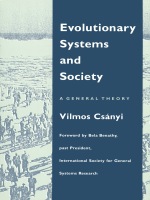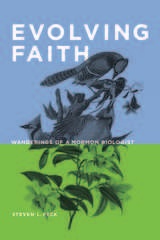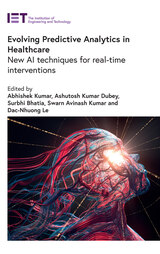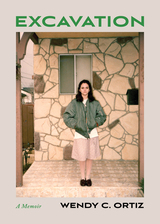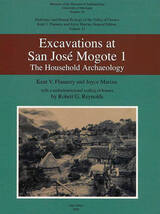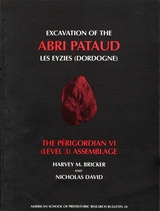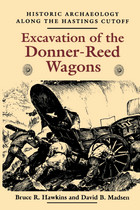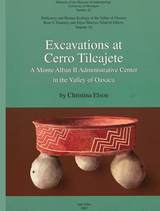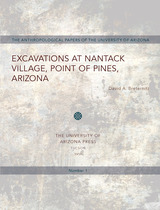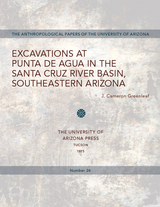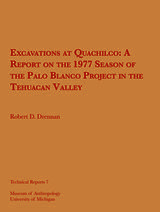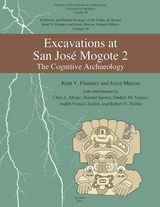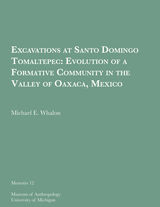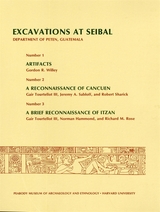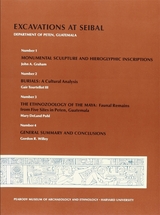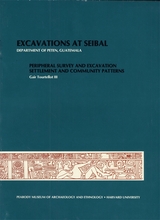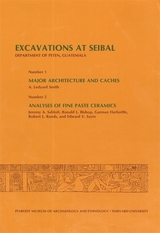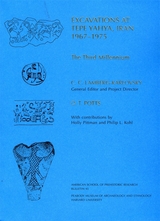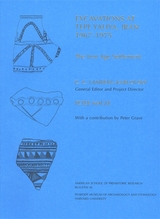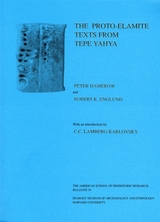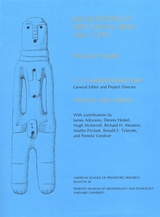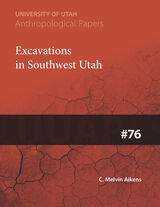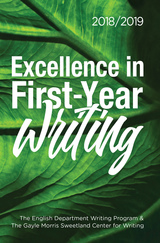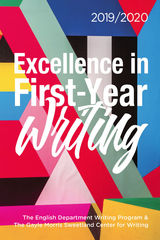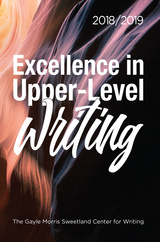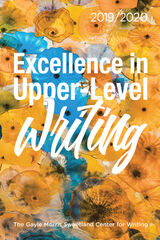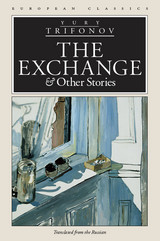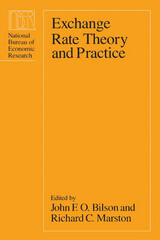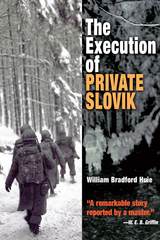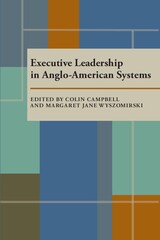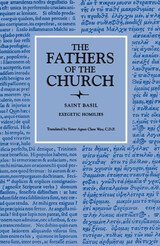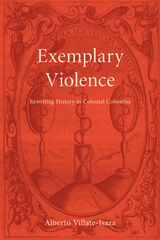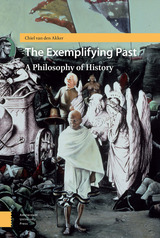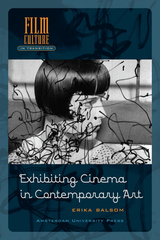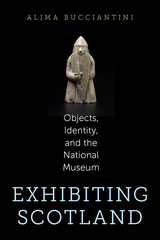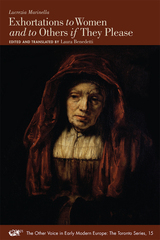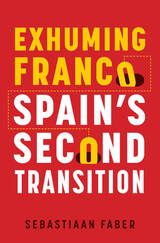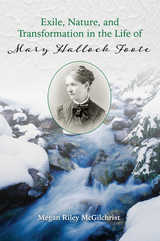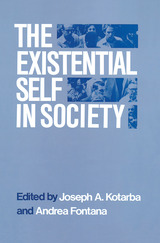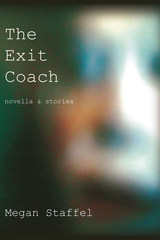Evolution of Vertebrate Design
Leonard B. Radinsky
University of Chicago Press, 1987 The Evolution of Vertebrate Design is a solid introduction to vertebrate evolution, paleontology, vertebrate biology, and functional, comparative anatomy. Its lucid style also makes it ideal for general readers intrigued by fossil history. Clearly drawn diagrams illustrate biomechanical explanations of the evolution of fins, jaws, joints, and body shapes among vertebrates. A glossary of terms is included.
"A luminous text is matched by lucid drawings rationally placed. . . . A great teaching monograph, the book will charm lay readers of fossil history. For virtually every college & public collection."—Scitech Book News
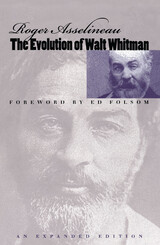 The Evolution of Walt Whitman
Roger Asselineau
University of Iowa Press, 1999 Now, nearly forty years after its original translation into English, Roger Asselineau's complete and magisterial biography of Walt Whitman will remind readers of the complex weave of traditions in Whitman scholarship. It is startling to recognize how much of our current understanding of Whitman was already articulated by Asselineau nearly half a century ago. Throughout its eight hundred pages, The Evolution of Walt Whitman speaks with authority on a vast range of topics that define both Whitman the man and Whitman the mythical personage. Remarkably, most of these discussions remain fresh and relevant, and that is in part because they have been so influential. In particular, The Evolution of Walt Whitman inaugurated the study of Leaves of Grass as a lifelong work in progress, and it marked the end of the habit of talking about Leaves as if it were a single unified book. Asselineau saw Whitman's poetry “not as a body of static data but as a constantly changing continuum whose evolution must be carefully observed.” Throughout Evolution, Asselineau placed himself in the role of the observer, analyzing Whitman's development with a kind of scientific detachment. But behind this objective persona burned the soul of a risk taker who was willing to rewrite Whitman studies by bravely proposing what was then a controversial biographical source for Whitman's art—his homosexual desires. The Evolution of Walt Whitman is a reminder that extraordinary works of criticism never exist in and of themselves. In this expanded edition, Roger Asselineau has provided a new essay summarizing his own continuing journey with Whitman. A foreword by Ed Folsom, editor of the Walt Whitman Quarterly, regards Evolution as the genesis of contemporary Whitman studies.
 Evolution: Selected Papers
Sewall Wright
University of Chicago Press, 1986 All of Sewall Wright's published papers on evolution up to 1950, and a few published later, are gathered in this volume. William Provine's introductions to each paper include pertinent references to related portions of Provine's Sewall Wright and Evolutionary Biology and Wright's four-volume masterwork, Evolution and the Genetics of Populations. By comparing the papers in this volume with the corresponding topics in the larger work, it is possible to determine the respects in which Wright extended, changed, or remained constant in his ideas over a period of sixty years.
Wright's shifting-balance theory of evolution, first conceived in 1925, has proved enormously useful in modern evolutionary biology. Wright's international prestige has never been higher than it is currently, and the time is ripe for a rereading of his seminal papers. These papers are not only historically important for understanding the period of the "evolutionary synthesis" of the 1930s and 1940s, but continue to be stimulating and useful to working evolutionary biologists today.
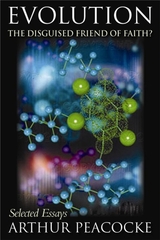 Evolution: The Disguised Friend of Faith?
Arthur Peacocke
Templeton Press, 2004
Arthur Peacocke, eminent priest-scientist, has collected thirteen of his essays for this volume. Previously published in various academic journals and edited books, the provocative essays expand upon the theme of the evolution of nature, humanity, and belief. They are grouped into three parts:
- Natural Evolution covers topics ranging from the implications of deterministic chaos; biological evolution and Christian theology; chance, potentiality, and God; complexity, emergence, and divine creativity.
- Humanity Evolving in the Presence of God, articulating God’s presence in and to the world as it is unveiled by the sciences; the chrysalis of the human; the nature and purpose of man in science and Christian theology.
- Theological Evolution—the Reshaping of Belief, dealing with science and the future of theology; public truth in religion; the incarnation of the self-expressive word of God; DNA; and the challenges and possibilities of western theism.
In the epilogue, Dr. Peacocke discusses wisdom in science and education, referring to Robert Grosseteste, a medieval scientist-theologian.
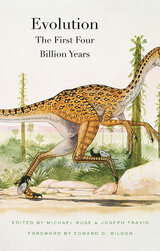 Evolution: The First Four Billion Years
Michael Ruse
Harvard University Press, 2011 Spanning evolutionary science from its inception to its latest findings, from discoveries and data to philosophy and history, this book is the most complete, authoritative, and inviting one-volume introduction to evolutionary biology available. Clear, informative, and comprehensive in scope, Evolution opens with a series of major essays dealing with the history and philosophy of evolutionary biology, with major empirical and theoretical questions in the science, from speciation to adaptation, from paleontology to evolutionary development (evo devo), and concluding with essays on the social and political significance of evolutionary biology today.
A second encyclopedic section travels the spectrum of topics in evolution with concise, informative, and accessible entries on individuals from Aristotle and Linneaus to Louis Leakey and Jean Lamarck; from T. H. Huxley and E. O. Wilson to Joseph Felsenstein and Motoo Kimura; and on subjects from altruism and amphibians to evolutionary psychology and Piltdown Man to the Scopes trial and social Darwinism. Readers will find the latest word on the history and philosophy of evolution, the nuances of the science itself, and the intricate interplay among evolutionary study, religion, philosophy, and society.
Appearing at the beginning of the Darwin Year of 2009—the 200th anniversary of the birth of Charles Darwin and the 150th anniversary of the publication of the Origin of Species—this volume is a fitting tribute to the science Darwin set in motion.
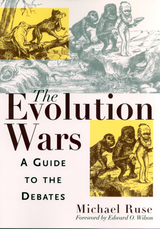 The Evolution Wars: A Guide to the Debates
Ruse, Michael
Rutgers University Press, 2001 The Evolution Wars draws on history, science, and philosophy to examine the development of evolutionary thought through the past two and a half centuries. It focuses on the debates that have engaged, divided, and ultimately provoked scientists to ponder the origins of organisms—including humankind—paying regard to the nineteenth-century clash over the nature of classification and debates about the fossil record, genetics, and human nature. Much attention is paid to external factors and the underlying motives of scientists.
In these pages you will meet Charles Darwin’s ebullient grandfather Erasmus, the contentious Frenchmen Georges Cuvier and Etienne Geoffroy Stain-Hillaire, new creationist Phillip Johnson, the brilliant J. B. S. Haldane, outspoken Richard Dawkins, and many other stars of the debates.
The Evolution Wars explores the ten greatest controversies surrounding evolution in world history, with emphasis on recent times, including the infamous Scopes trial of the 1920s: the search for human origins and speculation about the “missing link,” spurred by the discovery of “Lucy;” the debate surrounding the new theory of paleontology proposed by Stephen Jay Gould; and the rise of teaching “creation science” in public school as a subject on par with evolution. Although the author takes a strong stand on the side of evolution, he also shows respect for dissenting viewpoints. Thus, the book is intellectually rewarding not only for evolutionists but also for opponents of evolution theory, especially those who want to see how one of the great ideas of Western civilization resonates through time, both within and beyond the scientific community.
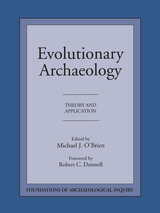 Evolutionary Archaeology - Paper
Michael J O'Brien
University of Utah Press, 1996
The application of Darwinian theory to archaeological phenomena has always been a difficult concept. In its most modern form, this approach has only gained currency since the 1980s. Perhaps the greatest hurdle to incorporating scientific evolutionism into archaeology is the necessary development of more than a rudimentary understanding of Darwinian evolution itself. Failure to recognize the conflict of anthropological terms such as "adaptation" and "fitness" with standard biological usage is fatal to any attempt to apply scientific evolutionism to the material record. Even more problematic are the outdated notions that human culture has allowed us to escape the effects of selection, that culture evolves, and that it does so in a progressive manner.
This volume assembles what might be considered the benchmark articles in evolutionary archaeology — articles that show how to apply scientific evolutionism to the study of variation in the archaeological record. It delineates an approach to the past in which artifacts are viewed as parts of human phenotypes and thus are subject to selection in the same manner as any somatic feature.
Evolutionary Archaeology: Theory and Application is aimed at archaeologists who want to understand the basics of evolutionary archaeology and who wish to do so from the beginning.
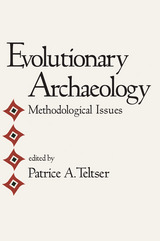 Evolutionary Archaeology: Methodological Issues
Patrice A. Teltser
University of Arizona Press, 1994 What is the role of neo-Darwinian evolution in explaining variation in prehistoric behavior? Evolutionary Archaeology, a collection of nine papers from a variety of contributors, is the first book-length treatment of the evolutionists' position. All archaeologists, and especially those with a specific interest in method and theory, will find much here to challenge traditional theory, solidify the evolutionists' position, and stir further debate.
Evolutionary archaeologists argue that Darwinian natural selection acts on human behavior, resulting in the persistence of alternative human behaviors and the material products of those behaviors. The contributors address the methodological requirements of evolutionary theory as it may apply to the nature of archaeological data. Several contributors evaluate the methodological implications of basic evolutionary principles, including the structure of explanations, the units of evolution and analysis, and the measurement of information transmission. Others explore the role of specific analytic approaches such as seriation, raw material sourcing, and comparative and engineering analyses. Still others confront the issue of reformulating archaeological problems from the point of view of evolutionary theory.
By focusing on the methodological requirements of evolutionary theory, these essays go far in meeting the challenge of building new archaeological method. The work contributes to a better understanding of cultural evolution and builds toward a new, logical framework to explain variation in the archaeological record.
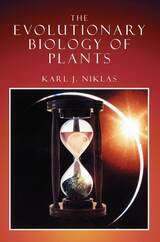 The Evolutionary Biology of Plants
Karl J. Niklas
University of Chicago Press, 1997 Although they are among the most abundant of all living things and provide essential oxygen, food, and shelter to the animal kingdom, few books pay any attention to how and why plants evolved the wondrous diversity we see today. In this richly illustrated and clearly written book, Karl J. Niklas provides the first comprehensive synthesis of modern evolutionary biology as it relates to plants.
After presenting key evolutionary principles, Niklas recounts the saga of plant life from its origins to the radiation of the flowering plants. To investigate how living plants might have evolved, Niklas conducts a series of computer-generated "walks" on fitness "landscapes," arriving at hypothetical forms of plant life strikingly similar to those of today and the distant past. He concludes with an extended consideration of molecular biology and paleontology. An excellent overview for undergraduates, this book will also challenge graduate students and researchers.
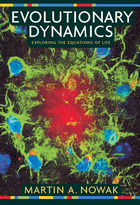 Evolutionary Dynamics: Exploring the Equations of Life
Martin A. Nowak
Harvard University Press, 2006 At a time of unprecedented expansion in the life sciences, evolution is the one theory that transcends all of biology. Any observation of a living system must ultimately be interpreted in the context of its evolution. Evolutionary change is the consequence of mutation and natural selection, which are two concepts that can be described by mathematical equations. Evolutionary Dynamics is concerned with these equations of life. In this book, Martin A. Nowak draws on the languages of biology and mathematics to outline the mathematical principles according to which life evolves. His work introduces readers to the powerful yet simple laws that govern the evolution of living systems, no matter how complicated they might seem.
Evolution has become a mathematical theory, Nowak suggests, and any idea of an evolutionary process or mechanism should be studied in the context of the mathematical equations of evolutionary dynamics. His book presents a range of analytical tools that can be used to this end: fitness landscapes, mutation matrices, genomic sequence space, random drift, quasispecies, replicators, the Prisoner’s Dilemma, games in finite and infinite populations, evolutionary graph theory, games on grids, evolutionary kaleidoscopes, fractals, and spatial chaos. Nowak then shows how evolutionary dynamics applies to critical real-world problems, including the progression of viral diseases such as AIDS, the virulence of infectious agents, the unpredictable mutations that lead to cancer, the evolution of altruism, and even the evolution of human language. His book makes a clear and compelling case for understanding every living system—and everything that arises as a consequence of living systems—in terms of evolutionary dynamics.
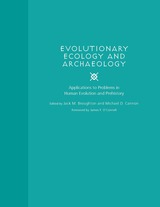 Evolutionary Ecology and Archaeology: Applications to Problems in Human Evolution and Prehistory
Jack M Broughton
University of Utah Press, 2009 The field of evolutionary ecology, which applies Darwinian natural selection theory to the study of adaptive design in behavior, morphology, and life history, has produced substantial advances in understanding human evolution and prehistory. Editors Jack Broughton and Michael Cannon have compiled archaeological and paleoanthro- pological studies that provide a foundation for sustained development of the study of the human past.
Each of the twenty-four contributions represents a key benchmark in the field. Chapters are grouped by substantive topic and/or time period. Each of the following sections includes an introduction by the editors:
• Early Hominid Evolution and Behavior
• Pleistocene Foragers and Colonists
• Post-Glacial Adaptations
• Food Production Strategies
• Cooperation and Competition in Complex Societies
This volume’s broad range of research will foster sustained development of evolutionary ecology, and like Darwin’s work nearly 150 years ago will open wide fields of understanding of human prehistory.
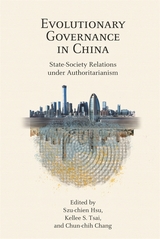 Evolutionary Governance in China: State–Society Relations under Authoritarianism
Szu-chien Hsu
Harvard University Press The People’s Republic of China has experienced numerous challenges and undergone tremendous structural changes over the past four decades. The party-state now faces a fundamental tension in its pursuit of social stability and regime durability. Repressive state strategies enable the Chinese Communist Party to maintain its monopoly on political power, yet the quality of governance and regime legitimacy are enhanced when the state adopts more inclusive modes of engagement with society.
Based on a dynamic typology of state–society relations, this volume adopts an evolutionary framework to examine how the Chinese state relates with non-state actors across several fields of governance. Drawing on original fieldwork, the authors identify areas in which state–society interactions have shifted over time, ranging from more constructive engagement to protracted conflict. This evolutionary approach provides nuanced insight into the circumstances wherein the party-state exerts its coercive power versus engaging in more flexible responses or policy adaptations.
 Evolutionary Innovations
Edited by Matthew H. Nitecki
University of Chicago Press, 1990 Evolutionary innovations—the bony skeleton of vertebrates, avian flight, or the insect pollination system of angiosperms, for example—have in recent years become the focus of much fertile new research in evolutionary biology. Innovations may hold the keys to understanding why whole new groups of organisms evolve or, conversely, why groups of organisms become extinct. This volume brings together contributors from the fields of morphology, genetics, embryology, physiology, and paleontology to present research on evolutionary innovations and to suggest directions for further work.
The topics covered include the plurality of evolutionary innovations, patterns and processes at different hierarchical levels, evolutionary genetics of adaptations, heterochrony and other mechanisms of radical evolutionary change in early development, developmental mechanisms at the origin of morphological novelty, the evolution of morphological variation patterns, functional design and its punctuated products, plausibility and testability in assessing the consequences of evolutionary innovations, paradigms and pitfalls of studying physiological evolution, polyphyletic constructional breakthroughs in fossil and extant species, ecology of evolutionary innovations in the fossil record.
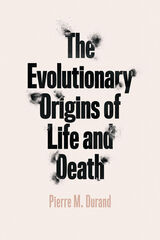 The Evolutionary Origins of Life and Death
Pierre M. Durand
University of Chicago Press, 2021 The question of why an individual would actively kill itself has long been an evolutionary mystery. Pierre M. Durand’s ambitious book answers this question through close inspection of life and death in the earliest cellular life. As Durand shows us, cell death is a fascinating lens through which to examine the interconnectedness, in evolutionary terms, of life and death. It is a truism to note that one does not exist without the other, but just how does this play out in evolutionary history?
These two processes have been studied from philosophical, theoretical, experimental, and genomic angles, but no one has yet integrated the information from these various disciplines. In this work, Durand synthesizes cellular studies of life and death looking at the origin of life and the evolutionary significance of programmed cellular death. The exciting and unexpected outcome of Durand’s analysis is the realization that life and death exhibit features of coevolution. The evolution of more complex cellular life depended on the coadaptation between traits that promote life and those that promote death. In an ironic twist, it becomes clear that, in many circumstances, programmed cell death is essential for sustaining life.
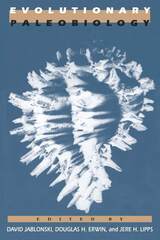 Evolutionary Paleobiology
Edited by David Jablonski, Douglas H. Erwin, and Jere H. Lipps
University of Chicago Press, 1996 Representing the state of the art in evolutionary paleobiology, this book provides a much-needed overview of this rapidly changing field. An influx of ideas and techniques both from other areas of biology and from within paleobiology itself have resulted in numerous recent advances, including increased recognition of the relationships between ecological and evolutionary theory, renewed vigor in the study of ecological communities over geologic timescales, increased understanding of biogeographical patterns, and new mathematical approaches to studying the form and structure of plants and animals.
Contributors to this volume—a veritable who's who of eminent researchers—present the results of original research and new theoretical developments, and provide directions for future studies. Individually wide ranging, these papers all share a debt to the work of James W. Valentine, one of the founders of modern evolutionary paleobiology. This volume's unified approach to the study of life on earth will be a major contribution to paleobiology, evolution, and ecology.
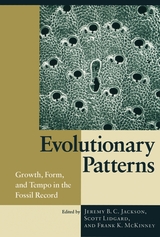 Evolutionary Patterns: Growth, Form, and Tempo in the Fossil Record
Edited by Jeremy B. C. Jackson, Scott Lidgard, and Frank K. McKinney
University of Chicago Press, 2001 With all the recent advances in molecular and evolutionary biology, one could almost wonder why we need the fossil record. Molecular sequence data can resolve taxonomic relationships, experiments with fruit flies demonstrate evolution and development in real time, and field studies of Galapagos finches have provided the strongest evidence for natural selection ever measured in the wild. What, then, can fossils teach us that living organisms cannot?
Evolutionary Patterns demonstrates the rich variety of clues to evolution that can be gleaned from the fossil record. Chief among these are the major trends and anomalies in species development revealed only by "deep time," such as periodic mass extinctions and species that remain unchanged in form for millions of years. Contributors explore modes of development, the tempo of speciation and extinction, and macroevolutionary patterns and trends. The result is an important contribution to paleobiology and evolutionary biology, and a spirited defense of the fossil record as a crucial tool for understanding evolution and development.
The contributors are Ann F. Budd, Efstathia Bura, Leo W. Buss, Mike Foote, Jörn Geister, Stephen Jay Gould, Eckart Hâkansson, Jean-Georges Harmelin, Lee-Ann C. Hayek, Jeremy B. C. Jackson, Kenneth G. Johnson, Nancy Knowlton, Scott Lidgard, Frank K. McKinney, Daniel W. McShea, Ross H. Nehm, Beth Okamura, John M. Pandolfi, Paul D. Taylor, and Erik Thomsen.
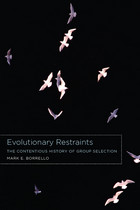 Evolutionary Restraints: The Contentious History of Group Selection
Mark E. Borrello
University of Chicago Press, 2010 Much of the evolutionary debate since Darwin has focused on the level at which natural selection occurs. Most biologists acknowledge multiple levels of selection—from the gene to the species. The debate about group selection, however, is the focus of Mark E. Borrello’s Evolutionary Restraints. Tracing the history of biological attempts to determine whether selection leads to the evolution of fitter groups, Borrello takes as his focus the British naturalist V. C. Wynne-Edwards, who proposed that animals could regulate their own populations and thus avoid overexploitation of their resources. By the mid-twentieth century, Wynne-Edwards became an advocate for group selection theory and led a debate that engaged the most significant evolutionary biologists of his time, including Ernst Mayr, G. C. Williams, and Richard Dawkins. This important dialogue bled out into broader conversations about population regulation, environmental crises, and the evolution of human social behavior. By examining a single facet in the long debate about evolution, Borrello provides powerful insight into an intellectual quandary that remains relevant and alive to this day.
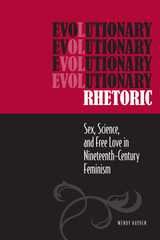 Evolutionary Rhetoric: Sex, Science, and Free Love in Nineteenth-Century Feminism
Wendy Hayden
Southern Illinois University Press, 2013 In Evolutionary Rhetoric, scholar Wendy Hayden provides a comprehensive examination of the relationship between scientific and feminist rhetorics in free-love feminism, studying the movement from its inception in the 1850s to its dark turn toward eugenics in the early 1900s. Hayden organizes her provocative study by scientific discipline—evolution, physiology, bacteriology, embryology, and heredity. Each chapter explores how free-love feminists adopted the evidence of that discipline in their arguments for increased sex education, women’s sexual rights, reproductive freedom, and the abolition of a marriage system that repressed the rights and the sexuality of women. Hayden takes our conventional understanding of the relationship between nineteenth-century feminism and science and expands it. The author provides examples of the powerful words of free-love feminists to show exactly how these exceptional women used science as a rhetorical platform to promote feminist, and often radical, social reforms. Considering why the free-love movement has not yet been studied, Hayden also discusses how the recovery of this movement may impact larger goals in the recovery of women’s rhetoric. This important and timely study of a long-forgotten movement adds to our understanding of the complexities of the history of feminism.
The Evolutionary Synthesis: Perspectives on the Unification of Biology, With a New Preface
Ernst Mayr
Harvard University Press Biology was forged into a single, coherent science only within living memory. In this volume the thinkers responsible for the “modern synthesis” of evolutionary biology and genetics come together to analyze that remarkable event.
In a new Preface, Ernst Mayr calls attention to the fact that scientists in different biological disciplines varied considerably in their degree of acceptance of Darwin’s theories. Mayr shows us that these differences were played out in four separate periods: 1859 to 1899, 1900 to 1915, 1916 to 1936, and 1937 to 1947. He thus enables us to understand fully why the synthesis was necessary and why Darwin’s original theory—that evolutionary change is due to the combination of variation and selection—is as solid at the end of the twentieth century as it was in 1859.
Evolutionary Systems and Society: A General Theory
Vilmos Csányi
Duke University Press, 1988 This work is a bold new effort to embrace all aspects of life—molecular, cellular, behavioral, and cultural—within the formulation of a general theory of evolution that extends classical Darwinian theory to include human society.
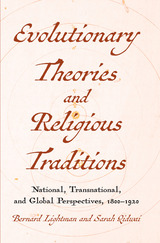 Evolutionary Theories and Religious Traditions: National, Transnational, and Global Perspectives, 1800-1920
Bernard Lightman
University of Pittsburgh Press, 2023 How Intellectuals and Global Publics Viewed the Relationship between Evolution and Diverse Religious Traditions
Before the advent of radio, conceptions of the relationship between science and religion circulated through periodicals, journals, and books, influencing the worldviews of intellectuals and a wider public. In this volume, historians of science and religion examine that relationship through diverse mediums, geographic contexts, and religious traditions. Spanning within and beyond Europe and North America, chapters emphasize underexamined regions—New Zealand, Australia, India, Argentina, Sri Lanka, Egypt, and the Ottoman Empire—and major religions of the world, including Christianity, Hinduism, Buddhism, Confucianism, and Islam; interactions between those traditions; as well as atheism, monism, and agnosticism. As they focus on evolution and human origins, contributors draw attention to European scientists other than Darwin who played a significant role in the dissemination of evolutionary ideas; for some, those ideas provided the key to understanding every aspect of human culture, including religion. They also highlight central figures in national contexts, many of whom were not scientists, who appropriated scientific theories for their own purposes. Taking a local, national, transnational, and global approach to the study of science and religion, this volume begins to capture the complexity of cultural engagement with evolution and religion in the long nineteenth century.
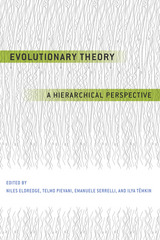 Evolutionary Theory: A Hierarchical Perspective
Edited by Niles Eldredge, Telmo Pievani, Emanuele Serrelli, and Ilya Temkin
University of Chicago Press, 2016 The natural world is infinitely complex and hierarchically structured, with smaller units forming the components of progressively larger systems: molecules make up cells, cells comprise tissues and organs that are, in turn, parts of individual organisms, which are united into populations and integrated into yet more encompassing ecosystems. In the face of such awe-inspiring complexity, there is a need for a comprehensive, non-reductionist evolutionary theory. Having emerged at the crossroads of paleobiology, genetics, and developmental biology, the hierarchical approach to evolution provides a unifying perspective on the natural world and offers an operational framework for scientists seeking to understand the way complex biological systems work and evolve.
Coedited by one of the founders of hierarchy theory and featuring a diverse and renowned group of contributors, this volume provides an integrated, comprehensive, cutting-edge introduction to the hierarchy theory of evolution. From sweeping historical reviews to philosophical pieces, theoretical essays, and strictly empirical chapters, it reveals hierarchy theory as a vibrant field of scientific enterprise that holds promise for unification across the life sciences and offers new venues of empirical and theoretical research. Stretching from molecules to the biosphere, hierarchy theory aims to provide an all-encompassing understanding of evolution and—with this first collection devoted entirely to the concept—will help make transparent the fundamental patterns that propel living systems.
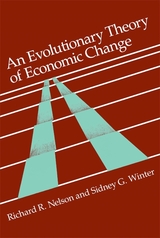 An Evolutionary Theory of Economic Change
Richard R. Nelson and Sidney G. Winter
Harvard University Press, 1982 This book contains the most sustained and serious attack on mainstream, neoclassical economics in more than forty years. Richard R. Nelson and Sidney G. Winter focus their critique on the basic question of how firms and industries change overtime. They marshal significant objections to the fundamental neoclassical assumptions of profit maximization and market equilibrium, which they find ineffective in the analysis of technological innovation and the dynamics of competition among firms.
To replace these assumptions, they borrow from biology the concept of natural selection to construct a precise and detailed evolutionary theory of business behavior. They grant that films are motivated by profit and engage in search for ways of improving profits, but they do not consider them to be profit maximizing. Likewise, they emphasize the tendency for the more profitable firms to drive the less profitable ones out of business, but they do not focus their analysis on hypothetical states of industry equilibrium.
The results of their new paradigm and analytical framework are impressive. Not only have they been able to develop more coherent and powerful models of competitive firm dynamics under conditions of growth and technological change, but their approach is compatible with findings in psychology and other social sciences. Finally, their work has important implications for welfare economics and for government policy toward industry.
 The Evolution-Creation Struggle
Michael Ruse
Harvard University Press, 2005 Creation versus evolution: What seems like a cultural crisis of our day, played out in courtrooms and classrooms across the county, is in fact part of a larger story reaching back through the centuries. The views of both evolutionists and creationists originated as inventions of the Enlightenment--two opposed but closely related responses to a loss of religious faith in the Western world.
In his latest book, Michael Ruse, a preeminent authority on Darwinian evolutionary thought and a leading participant in the ongoing debate, uncovers surprising similarities between evolutionist and creationist thinking. Exploring the underlying philosophical commitments of evolutionists, he reveals that those most hostile to religion are just as evangelical as their fundamentalist opponents. But more crucially, and reaching beyond the biblical issues at stake, he demonstrates that these two diametrically opposed ideologies have, since the Enlightenment, engaged in a struggle for the privilege of defining human origins, moral values, and the nature of reality.
Highlighting modern-day partisans as divergent as Richard Dawkins and Left Behind authors Tim LaHaye and Jerry B. Jenkins, Ruse's bracing book takes on the assumptions of controversialists of every stripe and belief and offers to all a new and productive way of understanding this unifying, if often bitter, quest.
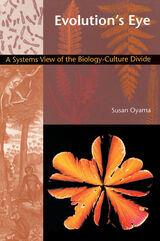 Evolution's Eye: A Systems View of the Biology-Culture Divide
Susan Oyama
Duke University Press, 2000 In recent decades, Susan Oyama and her colleagues in the burgeoning field of developmental systems theory have rejected the determinism inherent in the nature/nurture debate, arguing that behavior cannot be reduced to distinct biological or environmental causes. In Evolution’s Eye Oyama elaborates on her pioneering work on developmental systems by spelling out that work’s implications for the fields of evolutionary theory, developmental and social psychology, feminism, and epistemology. Her approach profoundly alters our understanding of the biological processes of development and evolution and the interrelationships between them.
While acknowledging that, in an uncertain world, it is easy to “blame it on the genes,” Oyama claims that the renewed trend toward genetic determinism colors the way we think about everything from human evolution to sexual orientation and personal responsibility. She presents instead a view that focuses on how a wide variety of developmental factors interact in the multileveled developmental systems that give rise to organisms. Shifting attention away from genes and the environment as causes for behavior, she convincingly shows the benefits that come from thinking about life processes in terms of developmental systems that produce, sustain, and change living beings over both developmental and evolutionary time.
Providing a genuine alternative to genetic and environmental determinism, as well as to unsuccessful compromises with which others have tried to replace them, Evolution’s Eye will fascinate students and scholars who work in the fields of evolution, psychology, human biology, and philosophy of science. Feminists and others who seek a more complex view of human nature will find her work especially congenial.
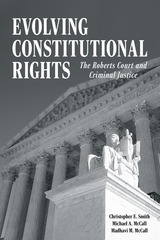 Evolving Constitutional Rights: The Roberts Court and Criminal Justice
Christopher E. Smith, Michael A. McCall, and Madhavi M. McCall
Southern Illinois University Press, 2025 Illuminating continuity and change in Supreme Court decisions
Evolving Constitutional Rights: The Roberts Court and Criminal Justice offers a compelling and in-depth analysis of how the U.S. Supreme Court has reshaped constitutional protections under Chief Justice John Roberts. Authors Christopher E. Smith, Michael A. McCall, and Madhavi M. McCall examine the Court’s significant decisions from 2005 to Justice Breyer’s retirement in 2022, revealing a complex judicial landscape where traditional doctrines are revised and fundamental rights are redefined.
The Roberts Court played a decisive role in some of the most contentious issues in American law. Due to several justices’ application of originalist interpretations, its rulings have reconfigured key constitutional protections—often in ways that expand the authority of law enforcement while constraining legislative power over criminal statutes. The trajectory of the Court’s conservative supermajority raises pressing questions about the future of constitutional rights.
Taking a rigorous yet accessible approach, Evolving Constitutional Rights breaks down the Court’s influence across the full spectrum of criminal justice issues, from sentencing and trial rights to search-and-seizure protections, Miranda warnings, and corrections policies. Using both legal and empirical analysis, the authors track patterns in judicial ideology, uncovering how the Roberts Court has not only reinforced conservative principles but also unexpectedly broadened rights in areas such as digital privacy and defense counsel obligations.
This timely and insightful book goes beyond historical rulings to offer a forward-looking perspective on the Supreme Court’s role in shaping public safety, legal precedent, and the balance of power in American government. Essential reading for legal scholars, policymakers, and anyone concerned with the future of constitutional rights, this new volume provides a clear and authoritative examination of the Roberts Court’s lasting impact on American law.
Evolving Creative Mindsets: Thinking through the Arts
Lynn F. C Yau
Hong Kong University Press, 2025 Why the future belongs to creative thinkers—and how the arts shape the way we learn.
For decades, arts education in Hong Kong has struggled to find its place within an exam-driven school system. In Evolving Creative Mindsets, Lynn F. C. Yau argues that the arts are not an extracurricular luxury but a vital force in shaping innovative minds. Drawing on over fourteen years of research and conversations with artists and educators, Yau makes a compelling case for integrating the arts more deeply into education, both as a subject and as a way of thinking.
From fostering critical problem-solving skills to preparing students for an unpredictable world, the arts provide tools for creativity and meaningful learning. This book is an essential resource for policymakers, educators, arts institutions, and those invested in reimagining the role of the arts in education.
Evolving Faith: Wanderings of a Mormon Biologist
Steven L. Peck
Neal A. Maxwell Institute for Religious Scholarship, 2015 Believers and scientists have long wrestled over the relationship between science and faith. Acclaimed Latter-day Saint author and scientist Steven L. Peck demonstrates that both are indispensable tools we can use to navigate God’s strange and beautiful creation. Evolving Faith: Wanderings of a Mormon Biologist is a collection of technical, personal, whimsical essays about Mormon theology, evolution, human consciousness, the environment, sacred spaces, and more. With the mind of a scientist, the soul of a believer, and the heart of a wanderer, Peck provides companionship for women and men engaged in the unceasing quest for further light and knowledge.
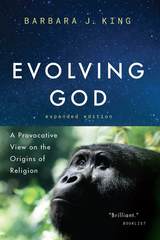 Evolving God: A Provocative View on the Origins of Religion, Expanded Edition
Barbara J. King
University of Chicago Press, 2017
Religion has been a central part of human experience since at least the dawn of recorded history. The gods change, as do the rituals, but the underlying desire remains—a desire to belong to something larger, greater, most lasting than our mortal, finite selves.
But where did that desire come from? Can we explain its emergence through evolution? Yes, says biological anthropologist Barbara J. King—and doing so not only helps us to understand the religious imagination, but also reveals fascinating links to the lives and minds of our primate cousins. Evolving God draws on King’s own fieldwork among primates in Africa and paleoanthropology of our extinct ancestors to offer a new way of thinking about the origins of religion, one that situates it in a deep need for emotional connection with others, a need we share with apes and monkeys. Though her thesis is provocative, and she’s not above thoughtful speculation, King’s argument is strongly rooted in close observation and analysis. She traces an evolutionary path that connects us to other primates, who, like us, display empathy, make meanings through interaction, create social rules, and display imagination—the basic building blocks of the religious imagination. With fresh insights, she responds to recent suggestions that chimpanzees are spiritual—or even religious—beings, and that our ancient humanlike cousins carefully disposed of their dead well before the time of Neandertals.
King writes with a scientist’s appreciation for evidence and argument, leavened with a deep empathy and admiration for the powerful desire to belong, a desire that not only brings us together with other humans, but with our closest animal relations as well.
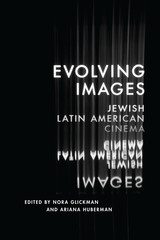 Evolving Images: Jewish Latin American Cinema
Edited by Nora Glickman and Ariana Huberman
University of Texas Press, 2017 Jews have always played an important role in the generation of culture in Latin America, despite their relatively small numbers in the overall population. In the early days of cinema, they served as directors, producers, screenwriters, composers, and broadcasters. As Latin American societies became more religiously open in the later twentieth century, Jewish characters and themes began appearing in Latin American films and eventually achieved full inclusion. Landmark films by Jewish directors in Argentina, Mexico, and Brazil, which are home to the largest and most influential Jewish communities in Latin America, have enjoyed critical and popular acclaim. Evolving Images is the first volume devoted to Jewish Latin American cinema, with fifteen critical essays by leading scholars from Latin America, the United States, Europe, and Israel. The contributors address transnational and transcultural issues of Jewish life in Latin America, such as assimilation, integration, identity, and other aspects of life in the Diaspora. Their discussions of films with Jewish themes and characters show the rich diversity of Jewish cultures in Latin America, as well as how Jews, both real and fictional, interact among themselves and with other groups, raising the question of how much their ethnicity may be adulterated when adopting a combined identity as Jewish and Latin American. The book closes with a groundbreaking section on the affinities between Jewish themes in Hollywood and Latin American films, as well as a comprehensive filmography.
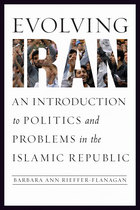 Evolving Iran: An Introduction to Politics and Problems in the Islamic Republic
Barbara Ann Rieffer-Flanagan
Georgetown University Press Evolving Iran presents an overview of how the politics and policy decisions in the Islamic Republic of Iran have developed since the 1979 revolution and how they are likely to evolve in the near future. Despite the fact that the revolution ushered in a theocracy, its political system has largely tended to prioritize self-interest and pragmatism over theology and religious values, while continuing to reinvent itself in the face of internal and international threats. The author also examines the prospects for democratization in Iran. Since the early years of the twentieth century, Iranians have attempted to make their political system more democratic, yet various attempts to produce a system where citizens have a meaningful voice in political decisions have failed. This book argues that greater democratization is unlikely to occur in the short term, especially in light of increased threats from the international community. This accessible overview of Iran’s political system covers a broad array of subjects, including foreign policy, human rights, women’s struggle for equality, the development and evolution of elections, and the institutions of the political system including the Revolutionary Guards and Assembly of Experts. It will appeal to undergraduates and the general public who seek to understand a country and regime that has mystified Westerners for decades.
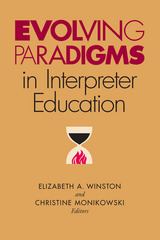 Evolving Paradigms in Interpreter Education
Elizabeth A. Winston
Gallaudet University Press, 2013 This volume brings together a cadre of world-renowned interpreting educators and researchers who conduct a rich exploration of paradigms, both old and new, in interpreter education. They review existing research, explicate past and current practices, and call for a fresh look at the roots of interpreter education in anticipation of the future. Expert commentary accompanies each chapter to provide a starting point for reflection on and discussion of the growing needs in this discipline.
Volume coeditor Christine Monikowski begins by considering how interpreter educators can balance their responsibilities of teaching, practice, and research. Her chapter is accompanied by commentary about the capacity to “academize” what has been thought of as a semi-profession. Helen Tebble shares research on medical interpreting from an applied linguistic perspective. Terry Janzen follows with the impact of linguistic theory on interpretation research methodology. Barbara Shaffer discusses how interpreting theory shapes the interpreter’s role. Elizabeth A. Winston, also a volume coeditor, rounds out this innovative collection with her chapter on infusing evidence-based teaching practices into interpreting education. Noted interpreter educators and researchers also provide an international range of insights in this collection, including Rico Peterson, Beppie van den Bogaerde, Karen Bontempo, Ian Mason, Ester Leung, David Quinto-Pozos, Lorraine Leeson, Jemina Napier, Christopher Stone, Debra Russell, and Claudia Angelelli.
Evolving Predictive Analytics in Healthcare: New AI techniques for real-time interventions
Abhishek Kumar
The Institution of Engineering and Technology, 2022 A major use of practical predictive analytics in medicine has been in the diagnosis of current diseases, particularly through medical imaging. Now there is sufficient improvement in AI, IoT and data analytics to deal with real time problems with an increased focus on early prediction using machine learning and deep learning algorithms. With the power of artificial intelligence alongside the internet of 'medical' things, these algorithms can input the characteristics/data of their patients and get predictions of future diagnoses, classifications, treatment and costs.
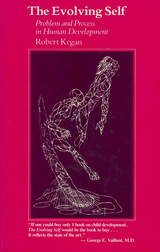 The Evolving Self: Problem and Process in Human Development
Robert Kegan
Harvard University Press, 1982 The Evolving Self focuses upon the most basic and universal of psychological problems—the individual’s effort to make sense of experience, to make meaning of life. According to Robert Kegan, meaning-making is a lifelong activity that begins in earliest infancy and continues to evolve through a series of stages encompassing childhood, adolescence, and adulthood. The Evolving Self describes this process of evolution in rich and human detail, concentrating especially on the internal experience of growth and transition, its costs and disruptions as well as its triumphs.
At the heart of our meaning-making activity, the book suggests, is the drawing and redrawing of the distinction between self and other. Using Piagetian theory in a creative new way to make sense of how we make sense of ourselves, Kegan shows that each meaning-making stage is a new solution to the lifelong tension between the universal human yearning to be connected, attached, and included, on the one hand, and to be distinct, independent, and autonomous on the other. The Evolving Self is the story of our continuing negotiation of this tension. It is a book that is theoretically daring enough to propose a reinterpretation of the Oedipus complex and clinically concerned enough to suggest a variety of fresh new ways to treat those psychological complaints that commonly arise in the course of development.
Kegan is an irrepressible storyteller, an impassioned opponent of the health-and-illness approach to psychological distress, and a sturdy builder of psychological theory. His is an original and distinctive new voice in the growing discussion of human development across the life span.
 The Evolving World: Evolution in Everyday Life
David P. Mindell
Harvard University Press, 2007 In the 150 years since Darwin, evolutionary biology has proven as essential as it is controversial, a critical concept for answering questions about everything from the genetic code and the structure of cells to the reproduction, development, and migration of animal and plant life. But today, as David P. Mindell makes undeniably clear in The Evolving World, evolutionary biology is much more than an explanatory concept. It is indispensable to the world we live in. This book provides the first truly accessible and balanced account of how evolution has become a tool with applications that are thoroughly integrated, and deeply useful, in our everyday lives and our societies, often in ways that we do not realize.
When we domesticate wild species for agriculture or companionship; when we manage our exposure to pathogens and prevent or control epidemics; when we foster the diversity of species and safeguard the functioning of ecosystems: in each of these cases, Mindell shows us, evolutionary biology applies. It is at work when we recognize that humans represent a single evolutionary family with variant cultures but shared biological capabilities and motivations. And last but not least, we see here how evolutionary biology comes into play when we use knowledge of evolution to pursue justice within the legal system and to promote further scientific discovery through education and academic research.
More than revealing evolution's everyday uses and value, The Evolving World demonstrates the excitement inherent in its applications--and convinces us as never before that evolutionary biology has become absolutely necessary for human existence.
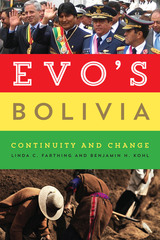 Evo's Bolivia: Continuity and Change
By Linda C. Farthing and Benjamin H. Kohl
University of Texas Press, 2014 In this compelling and comprehensive look at the rise of Evo Morales and Bolivia’s Movimiento al Socialismo (MAS), Linda Farthing and Benjamin Kohl offer a thoughtful evaluation of the transformations ushered in by the western hemisphere’s first contemporary indigenous president. Accessible to all readers, Evo’s Bolivia not only charts Evo’s rise to power but also offers a history of and context for the MAS revolution’s place in the rising “pink tide” of the political left. Farthing and Kohl examine the many social movements whose agendas have set the political climate in Bolivia and describe the difficult conditions the administration inherited. They evaluate the results of Evo’s policies by examining a variety of measures, including poverty; health care and education reform; natural resources and development; and women’s, indigenous, and minority rights. Weighing the positive with the negative, the authors offer a balanced assessment of the results and shortcomings of the first six years of the Morales administration. At the heart of this book are the voices of Bolivians themselves. Farthing and Kohl interviewed women and men in government, in social movements, and on the streets throughout the country, and their diverse backgrounds and experiences offer a multidimensional view of the administration and its progress so far. Ultimately the “process of change” Evo promised is exactly that: an ongoing and complicated process, yet an important example of development in a globalized world.
 Ex Situ Plant Conservation: Supporting Species Survival In The Wild
Edited by Edward O. Guerrant Jr., Kayri Havens, and Mike Maunder; Foreword by Peter H. Raven ; Society for Ecological Restoration International Center for Plant Conservation
Island Press, 2004 Faced with widespread and devastating loss of biodiversity in wild habitats, scientists have developed innovative strategies for studying and protecting targeted plant and animal species in "off-site" facilities such as botanic gardens and zoos. Such ex situ work is an increasingly important component of conservation and restoration efforts. Ex Situ Plant Conservation, edited by Edward O. Guerrant Jr., Kayri Havens, and Mike Maunder, is the first book to address integrated plant conservation strategies and to examine the scientific, technical, and strategic bases of the ex situ approach. The book examines where and how ex situ investment can best support in situ conservation. Ex Situ Plant Conservation outlines the role, value, and limits of ex situ conservation as well as updating best management practices for the field, and is an invaluable resource for plant conservation practitioners at botanic gardens, zoos, and other conservation organizations; students and faculty in conservation biology and related fields; managers of protected areas and other public and private lands; and policymakers and members of the international community concerned with species conservation.
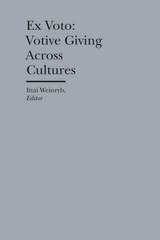 Ex Voto: Votive Giving Across Cultures
Edited by Ittai Weinryb
Bard Graduate Center, 2015 Derived from Latin ex voto suscepto “in pursuance of a vow,” an ex voto embodies the hopes, dreams, and anxieties of the person who deposits it. Almost anything, regardless of size, weight, form, or original function, can become a votive object. Ultimately, the category refers to a subset of the material world in which a thing is not necessarily made to be a votive, but instead becomes charged with votive meaning once dedicated to a deity or deities. This volume, one of the first collections devoted exclusively to the subject, builds on the assumption that a shared conceptual framework underpins votive objects, and that by merit of their consecration they have become a category representing a special stage in the life of a material.
The contributors to this comparative study examine ex votos across a range of locations and time periods, including the classical Mediterranean world, medieval Europe, the period of the Catholic Reform, and on to Mexico, Shinto and Buddhist Japan, and Muslim Iran. Voluminous and diverse, Ex Voto will appeal in a wide range of fields, including history, religion, and anthropology.
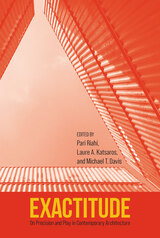 Exactitude: On Precision and Play in Contemporary Architecture
Edited by Pari Riahi, Laure Katsaros, and Michael T. Davis
University of Massachusetts Press, 2022 Precision is necessary in the field of architecture, and new technologies have increased demands for accuracy, particularly when the smallest errors can have outsized consequences. However, the importance of precision, or exactitude, has not received the consideration it merits. While themes of sustainability, performance, and formal innovation have been at the forefront of architectural scholarship for the past twenty years, this book moves beyond these concerns to explore the theoretical and practical demands exactitude makes on architecture as a field. The eleven essays collected here investigate the possibilities and shortcomings of exactitude and delve into current debates about the state of contemporary architecture as both a technological craft and artistic creation. Featuring new work by leading theorists, historians, editors, architects, and scholars, this volume brings theory and practice into insightful and productive conversations. In addition to the editors, contributors include Mark Wigley, Alejandro Zaera-Polo, Eric Höweler, Christopher Benfey, Sunil Bald, Ada Tolla and Giuseppe Lignano with Thomas de Monchaux, Alicia Imperiale, Francesca Hughes, Teresa Stoppani, and Cynthia Davidson.
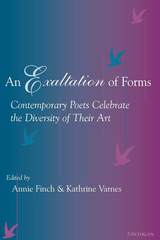 An Exaltation of Forms: Contemporary Poets Celebrate the Diversity of Their Art
Annie Finch and Kathrine Varnes, Editors
University of Michigan Press, 2002 At once handbook, reader, and guide to the literary tastes and wisdom of poets, An Exaltation of Forms is an indispensable resource certain to find a dedicated audience among poetry lovers. The editors invited over fifty contemporary poets to select a poetic meter, stanza, or form, describe it, recount its history, and provide favorite examples. The essays represent a remarkably diverse range of literary styles and approaches, and show how the forms of contemporary English-language poetry derive from a wealth of different traditions.
The forms range from hendecasyllabics to prose poetry, haiku to procedural poetry, sonnets to blues, rap to fractal verse. The range of poets included is equally impressive--from Amiri Baraka to John Frederick Nims, from Maxine Kumin to Marilyn Hacker, from Agha Shahid Ali to Pat Mora, from W. D. Snodgrass to Charles Bernstein. Achieving this level of eclecticism is a remarkable feat, especially given the strong opinions held by members of the various camps (e.g., the New Formalists, LANGUAGE poets, feminist and multicultural poets) that exist within today's poetry community. Poets who might never occupy the same room here occupy the same pages, perhaps for the first time. The net effect is a book that will surprise, inform, and delight a wide range of readers, whether as reference book, pleasure reading, or classroom text.
Poet, translator, and critic Annie Finch is director of the Stonecoast low-residency MFA program at the University of Southern Maine. She is author of The Ghost of Meter: Culture and Prosody in American Free Verse, Eve, and Calendars. She is the winner of the eleventh annual Robert Fitzgerald Prosody Award for scholars who have made a lasting contribution to the art and science of versification. Kathrine Varnes teaches English at the University of Missouri-Columbia. She is the author of the book of poems, The Paragon. Her poems and essays have appeared in many books and journals.
 An Exaltation of Parks: John D. Rockefeller Jr.'s Crusade to Save America's Wonderlands
Steve Kemp
University of Utah Press, 2025 Uncovering the partnership that saved America’s natural treasures
America’s national parks are facing unprecedented challenges. With visitation pressures mounting and the National Park Service struggling to keep up, author and former park ranger Steve Kemp looks toward one exceptionally effective historical example of conservation philanthropy and park building—the collaboration between John D. Rockefeller Jr. and NPS legends Stephen Mather, Horace Albright, and Arno Cammerer.
An Exaltation of Parks reveals the inspiring story of this collaboration, showing how the partnership transformed some of America's most cherished national parks, including Acadia, Grand Teton, Great Smoky Mountains, Yellowstone, and Yosemite. It recounts Rockefeller’s lifelong dedication to conservation, digging into his own pockets and toiling as a volunteer to achieve his goals for converting private land into public use. Bringing to life the history and significance of America’s most magnificent landscapes, this volume is both a tribute to past conservation victories and a call to action for the future, emphasizing the need for continued vigilance to preserve these national treasures for generations to come.
Exam Preparation: Electrical Installations (2391)
The Institution of Engineering and Technology
The Institution of Engineering and Technology, 2017 This level 3 qualification helps learners develop the knowledge and practical skills required to carry out inspection and testing on electrical installations.
Exam Preparation Requirements for Electrical Installations (2382-18)
The Institution of Engineering and Technology
The Institution of Engineering and Technology, 2019 This book has been written as a practice aid for the examination you will need to take to complete the Level 3 Award in Requirements for Electrical Installations: BS 7671 (2382-18).
Exam Preparation Requirements for Electrical Installations: Level 3 Award
The Institution of Engineering and Technology
The Institution of Engineering and Technology, 2025 This book is an essential practice aid for the examination required to complete the City & Guilds and EAL Level 3 qualifications, Requirements for Electrical Installations, updated in accordance with BS 7671:2018+A2:2022.
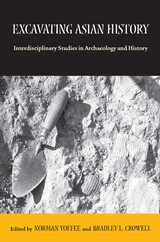 Excavating Asian History: Interdisciplinary Studies in Archaeology and History
Norman Yoffee
University of Arizona Press, 2006 Although history and archaeology each seek to elucidate the past, both sets of data are incomplete and ambiguous and thus open to multiple readings that invite contradictory interpretations of human activity. This is particularly true when scholars of each field ignore or fail to understand research in the other discipline.
Excavating Asian History contains case studies and theoretical articles that show how archaeologists have been investigating historical, social, and economic organizations and that explore the relationship between history and archaeology in the study of pre-modern Asia. These contributions consider biases in both historical and archaeological data that have occasioned rival claims to knowledge in the two disciplines. Ranging widely across the region from the Levant to China and from the third millennium BC to the second millennium AD, they demonstrate that archaeological and historical studies can complement each other and should be used in tandem.
The contributors are leading historians and archaeologists of Asia who present data, issues, and debates revolving around the most recent research on the ancient Near East, early Islam, India, China, and Southeast Asian states. Their chapters illustrate the benefits of interdisciplinary investigations and show in particular how archaeology is changing our understanding of history. Commentary chapters by Miriam Stark and Philip Kohl add new perspectives to the findings.
By showing the evolving relationship between those who study archaeological material and those who investigate textual data, Excavating Asian History offers practical demonstrations of how research has been and must continue to be structured.
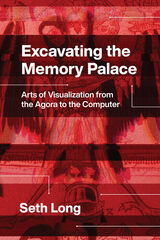 Excavating the Memory Palace: Arts of Visualization from the Agora to the Computer
Seth Long
University of Chicago Press, 2020 With the prevalence of smartphones, massive data storage, and search engines, we might think of today as the height of the information age. In reality, every era has faced its own challenges of storing, organizing, and accessing information. While they lacked digital devices, our ancestors, when faced with information overload, utilized some of the same techniques that underlie our modern interfaces: they visualized and spatialized data, tying it to the emotional and sensory spaces of memory, thereby turning their minds into a visual interface for accessing information.
In Excavating the Memory Palace, Seth David Long mines the history of Europe’s arts of memory to find the origins of today’s data visualizations, unearthing how ancient constructions of cognitive pathways paved the way for modern technological interfaces. Looking to techniques like the memory palace, he finds the ways that information has been tied to sensory and visual experience, turning raw data into lucid knowledge. From the icons of smart phone screens to massive network graphs, Long shows us the ancestry of the cyberscape and unveils the history of memory as a creative act.
Excavation: A Memoir
Wendy C. Ortiz
Northwestern University Press, 2025 The acclaimed and groundbreaking memoir from Wendy C. Ortiz
A darkly vibrant and daring memoir, Wendy C. Ortiz’s Excavation challenged the standard telling of abuse narratives when first published in 2014; over a decade later, it remains deeply prescient. Set in Los Angeles’s San Fernando Valley in the late 1980s, the narrative follows the spiraling entanglement between Wendy and her eighth-grade English teacher as she becomes both victim to and participant in a simultaneously predatorial and impassioned relationship. Baited by initial praise and a false sense of control, Wendy tumbles into a dangerous dynamic that spans the duration of her teens. Artfully constructed from her own journals and decades of personal excavation, the story of this secret relationship has imprinted on Wendy and readers alike. A stunningly honest look at memory, agency, and power, Excavation will claim your whole heart.
Excavation at San José Mogote 1: The Household Archaeology
Kent V. Flannery and Joyce Marcus with a multidimensional scaling of houses by Robert G. Reynolds
University of Michigan Press, 2005 San José Mogote, an early village and chiefly center in Mexico’s Oaxaca Valley, was excavated over a fifteen-year period. This volume reports in detail on every Early and Middle Formative house recovered, including a complete inventory of artifacts, features, plants, animal bones, and craft raw materials by house, with extensive piece-plotting of items on house floors and dooryards.
Excavation of the Abri Pataud, Les Eyzies (Dordogne)
Harvey M. Bricker and Nicholas David
Harvard University Press This third volume of the Excavation of the Abri Pataud rock shelter in southern France focuses on the occupation that began about 27,000 years ago and compares the materials with artifacts from more than 50 sites in Italy, Spain, and France.
Excavations at Iktanu in the South Jordan Valley, Jordan
Kay Prag
Council for British Research in the Levant, 2024 Iktanu is a large double site in the southeast Jordan Valley occupied, with long periods of abadonment, during the late fourth/early third, the late third, and the first millennia BC. Excavation focussed on archaeological assemblages and chronology, and the complex evidence for the establishment, nature, scale, wider relationships and abandonment of settlement in each period, from small agro-pastoral village, to a larger scale, possibly transhumant population, to a Persian period fort, in a hinterland impacted by the convergence of diverse geological and geographical zones.
Excavations at Nantack Village, Point of Pines, Arizona
David A. Breternitz
University of Arizona Press, 1959 The Anthropological Papers of the University of Arizona is a peer-reviewed monograph series sponsored by the School of Anthropology. Established in 1959, the series publishes archaeological and ethnographic papers that use contemporary method and theory to investigate problems of anthropological importance in the southwestern United States, Mexico, and related areas.
Excavations at San José Mogote 2: The Cognitive Archaeology
Kent V. Flannery and Joyce Marcus with contributions by Chris L. Moser, Ronald Spores, Dudley M. Varner, Judith Francis Zeitlin, and Robert N. Zeitlin
University of Michigan Press, 2005 San José Mogote is a 60-70 ha Formative site in the northern Valley of Oaxaca, Mexico, which was occupied for a thousand years before the city of Monte Albán was founded. Filling 432 pages and utilizing more than 400 photographs and line drawings, this book describes in detail more than 35 public buildings, including men’s houses, one-room temples, a performance platform, two-room state temples, a ballcourt, and two types of palaces.
Excavations at Seibal, Department of Peten, Guatemala
Gordon R. Willey; Gair Tourtellot, III; Jeremy A. Sabloff; Robert Sharick; Norman Hammond; and Richard M. Rose
Harvard University Press, 1978 Seibal is a major ruin of the southern Maya lowlands, its vast ceremonial center covering several high hills on the banks of the Pasión River in the Guatemalan Department of Petén. In five volumes published over a 15-year period, the archaeological team headed by Gordon R. Willey presents a comprehensive review of their fieldwork from 1964 to 1968 and the results of many years of subsequent data analysis.
The volumes also report on explorations in the peripheral settlements outside of the Seibal center and provide a regional view of the evolution of lowland Maya culture from the Middle and Late Preclassic through the Late Classic periods.
Excavations at Seibal, Department of Peten, Guatemala
Gordon R. Willey; Gordon R. Willey; John A. Graham; Gair Tourtellot, III; and Mary Pohl
Harvard University Press, 1990 Seibal is a major ruin of the southern Maya lowlands, its vast ceremonial center covering several high hills on the banks of the Pasión River in the Guatemalan Department of Petén. In five volumes published over a 15-year period, the archaeological team headed by Gordon R. Willey presents a comprehensive review of their fieldwork from 1964 to 1968 and the results of many years of subsequent data analysis.
The volumes also report on explorations in the peripheral settlements outside of the Seibal center and provide a regional view of the evolution of lowland Maya culture from the Middle and Late Preclassic through the Late Classic periods.
Excavations at Seibal, Department of Peten, Guatemala
Gair Tourtellot, III; edited by Gordon R. Willey
Harvard University Press, 1988 Seibal is a major ruin of the southern Maya lowlands, its vast ceremonial center covering several high hills on the banks of the Pasión River in the Guatemalan Department of Petén. In five volumes published over a 15-year period, the archaeological team headed by Gordon R. Willey presents a comprehensive review of their fieldwork from 1964 to 1968 and the results of many years of subsequent data analysis.
The volumes also report on explorations in the peripheral settlements outside of the Seibal center and provide a regional view of the evolution of lowland Maya culture from the Middle and Late Preclassic through the Late Classic periods.
Excavations at Seibal, Department of Peten, Guatemala
A. Ledyard Smith, Jeremy A. Sabloff, Ronald L. Bishop, Garman Harbottle, Robert L. Rands, Edward V. Sayre, and Gordon R. Willey
Harvard University Press, 1982 Seibal is a major ruin of the southern Maya lowlands, its vast ceremonial center covering several high hills on the banks of the Pasión River in the Guatemalan Department of Petén. In five volumes published over a 15-year period, the archaeological team headed by Gordon R. Willey presents a comprehensive review of their fieldwork from 1964 to 1968 and the results of many years of subsequent data analysis.
The volumes also report on explorations in the peripheral settlements outside of the Seibal center and provide a regional view of the evolution of lowland Maya culture from the Middle and Late Preclassic through the Late Classic periods.
Excavations at Seibal, Department of Peten, Guatemala
Gordon R. Willey; A. Ledyard Smith; Gair Tourtellot, III; Ian Graham; and Jeremy A. Sabloff
Harvard University Press Seibal is a major ruin of the southern Maya lowlands, its vast ceremonial center covering several high hills on the banks of the Pasion River in the Guatemalan Department of Peten. In five volumes published over a 15-year period, the archaeological team headed by Gordon R. Willey presents a comprehensive review of their fieldwork from 1964 to 1968 and the results of many years of subsequent data analysis. The volumes also report on explorations in the peripheral settlements outside of the Seibal center and provide a regional view of the evolution of lowland Maya culture from the Middle and Late Preclassic through the Late Classic periods.
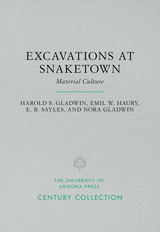 Excavations at Snaketown: Material Culture
Harold S. Gladwin, Emil W. Haury, E. B. Sayles, and Nora Gladwin
University of Arizona Press, 1965 "[Gladwin] accomplished, from the 1920's on, a series of fundamentally important studies of the prehistoric cultures of the region from Texas to California. None of these surveys or excavations was more important than the excavation of Snaketown, in the southern Arizona desert. It provided a wealth of details for a major prehistoric culture, the Hohokam, which previously had been scarcely recognized. It dislodged many long-held dogmas of Southwestern archaeology and provided the basis for a major reorientation in thinking about the nature of the prehistoric occupations of Arizona and adjacent states. . . . [This volume] has remained indispensable for its detailed reporting of house remains, ball courts, canals, cremations, pottery, carved stone, and other artifacts."—Science
"The reprint will come as a blessing to many archaeologists who have sought in vain to obtain a copy of the original volume. It now stands as a body of data easily accessible to all workers, and we look forward to a new phase of synthesis of Hohokam archaeology."—American Antiquity
 Excavations at Tel Michal, Israel
Ze’ev Herzog, Ora Negbi, and George Rapp Jr., Editors
University of Minnesota Press, 1989
Excavations at Tel Michal, Israel was first published in 1989. Minnesota Archive Editions uses digital technology to make long-unavailable books once again accessible, and are published unaltered from the original University of Minnesota Press editions.
The archaeological site known today as Tel Michal lies north of Tel Aviv on Israel's coastal plain, high on a barren windswept cliff overlooking the Mediterranean. Lacking the arable soil that might have encouraged permanent settlement - most of the region is covered with sand dunes - Tel Michael was probably a maritime station for military or commercial use during its period of occupation, which extended intermittently from the Canaanite Period (Middle Bronze Age II, about 2000 B.C.) through the Early Arab Period (ninth century A.D.). The site's archaeological remains are not confined to a single ancient tel or mound but are dispersed over five hills, where, despite severe erosion, seventeen strata have been excavated, yielding particularly rich and extensive finds in the Persian period.
The excavations at Tel Michal were conducted over a period of four summers, from 1977 through 1980, by a consortium that included Tel Aviv University and the University of Minnesota. As the first phase in a much broader regional project, Tel Michal drew together a multinational group of scholars and students in a cooperative, interdisciplinary effort like that pioneered in Greek archaeology by the Minnesota Messenia Expedition. Experts in traditional archaeological fields—pottery, architecture, numismatics—were joined by geologists, metallurgists, botanists, zoologists, and materials scientists; 43 of these participants have contributed to this full report of the excavations.
The book first traces the historical geography and settlement patterns of Tel Michal and its environs, then covers the stratigraphy and architecture of its settlements during the Bronze and Iron ages and the Persian, Hellenistic, and Arab periods. Included in this historical section are chapters on pottery and on special finds like the Iran Age winepresses, the Persian cemetery, and the Roman fortress. Subsequent chapters deal with the region's geology and its botanical and skeletal remains; with computerized, petrographic, and chemical modes of analysis; and with metal and flint objects, numismatics, and small finds like seals, glass artifacts, beads and pendants. Illustrated throughout with line drawings and tables, by photographs of the excavation site and many of the artifacts found there.
Excavations at Tepe Yahya, Iran, 1967-1975
D. T. Potts
Harvard University Press, 2001 Situated roughly midway between the great cities of the Indus Valley and those of the Mesopotamian plains, Tepe Yahya occupies a special place in our conceptions of relations between these distant territories during the early Bronze Age. Its third-millennium levels, dating from 3000 to 2100 BC, are particularly important.
In this definitive study, D. T. Potts describes the stratigraphy, architecture, ceramics, and chronology of the site and presents a full inventory of the small finds. Holly Pittman contributes comprehensive illustrations and a discussion of the seals and sealings, and Philip Kohl provides an analysis of the carved chlorite industry. In a foreword and afterword, project director C. C. Lamberg-Karlovsky tells the story of the archaeological expedition and reflects on the contributions of the Tepe Yahya project.
Excavations at Tepe Yahya, Iran, 1967-1975
Peter Magee
Harvard University Press, 2004 Tepe Yahya provides a stratigraphic sequence that stretches some 6,000 years, from the Neolithic period to the early centuries AD. As a result, the site is critical for understanding cultural processes in southeastern Iran.
In this volume of results of the excavations at Tepe Yahya, Peter Magee presents evidence from the Iron Age occupation of the site. Looking beyond the epigraphic and historical data and examining the insights provided by the artifactual record, Magee describes how a small settlement, located some distance from the main centers of power, came into being and was affected by the emergence of the Achaemenid imperial system, which stretched from Pakistan to Libya.
Excavations at Tepe Yahya, Iran, 1967-1975
Peter Damerow and Robert K. EnglundIntroduction by C. C. Lamberg-Karlovsky
Harvard University Press, 1989 This comprehensive study of the Proto-Elamite language (ca. 3000 BC) is based on a small archive recovered from the site of Tepe Yahya in southeastern Iran. The authors, two of the leading specialists on the most ancient written texts of the Near East, illuminate the structure of the texts, the numerical sign systems used, and the relation of Proto-Elamite to other protocuneiform writing systems. A computer-generated sign list compares the written archive from Tepe Yahya with those of other archaeological sites from which Proto-Elamite texts have been recovered.
The volume offers a new understanding of the language and culture of the Proto-Elamites as well as important insights into the economic structure of the earliest literate civilizations. With a new preface by the authors.
Excavations at Tepe Yahya, Iran, 1967-1975
Thomas Wight Beale and C. C. Lamberg-Karlovsky
Harvard University Press, 1986 Excavations at Tepe Yahya describes the geographical and paleoenvironmental setting of Tepe Yahya and details the earliest architecture at the site, the production of ceramics and metallurgy, and the excavation’s small finds. Interpretive essays examine settlement patterns, change and development over time, and the community’s setting in the wider context of core–periphery interaction in the fifth and fourth millennia BC.
Excavations at the Lake George Site, Yazoo Country, Mississippi, 1958–1960
Stephen Williams and Jeffrey P. Brain
Harvard University Press, 1983 This milestone volume describes and interprets excavations at one of the greatest late prehistoric sites in the southeastern United States. Lake George reached its zenith between the thirteenth and fifteenth centuries A.D., during the florescence of the Mississippian culture. This is a detailed analysis of the site and its relationship to the corpus of Southeastern archaeology.
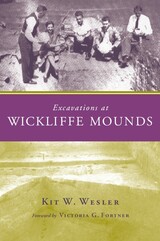 Excavations at Wickliffe Mounds
Kit W. Wesler, with a foreword by Victoria G. Fortner
University of Alabama Press, 2001 Wesler provides an impressive and definitive compilation of more than 70 years of archaeological excavations at one of the most important
archaeological sites in Kentucky. The Wickliffe Mounds site is located on a bluff overlooking the Mississippi River in Ballard County, Kentucky, about three miles south of the mouth of the Ohio River. Around A.D. 1100, Mississippian people--farmers and traders with a culture closely related to the historic cultures of the Southeast (Chickasaw, Choctaw, Creek, and others)—created a settlement there on which they lived for approximately 250 years before moving on. In 1930 road construction cut a channel through the site, revealing archaeological deposits and bringing the area to the attention of Fain King, a local lumberman and entrepreneur. King bought the site in hopes of turning it into an attraction for the education and entertainment of the public, and not incidentally for his own profit. For more than 50 years the area was subjected to excavations ranging from looting to professional research efforts. In 1983, the site was finally turned over to Murray State University to be developed into an academic facility dedicated to research, student training, public education, and preservation of the site and its collections. Fortunately, the Wickliffe collections include all the early excavation records as well as more than 85,000 artifacts, 90% of which had been catalogued. Between 1984 and 1996 excavations were conducted specifically to affirm questionable data and/or fill in gaps in the Wickliffe archaeological record. In this volume, Wesler and his colleagues have compiled data from almost seven decades of excavations at Wickliffe Mounds, providing the first comprehensive study of this important site. The paperback version of the book is accompanied by a CD-ROM that contains contributions from a wide range of archaeological specialists and includes archaeological data, site maps, database files, plats of excavations, artifact descriptions, and photographs, compiling in one place the entire archaeological record for this very important eastern North American site.
Excavations in Southwest Utah: UUAP 76
C. Melvin Aikens
University of Utah Press, 1965 AKA Glen Canyon Series Number 27. This volume reports on sites excavated in southwest Utah, three near St. George, three in Zion National Park, and two in Johnson Canyon, east of Kanab. The appendix also describes additional sites that were surveyed in these areas.
 Excellence for All: How a New Breed of Reformers Is Transforming America's Public Schools
Jack Schneider
Vanderbilt University Press, 2011 By the early twentyfirst century, a startling consensus had emerged about the overall aim of American school reform. In an era of political discord, and in a field historically known for contentiousness, the notion of promoting educational excellence for all students was a distinct point of bipartisan agreement. Shaped by a corps of entrepreneurial reformers intent on finding "what works" and taking it to scale, this hybrid vision won over the nation's most ambitious and wellresourced policy leaders at foundations and nonprofits, in state and federal government, and in urban school districts from coast to coast. "Excellence for all" might, at first glance, appear to be nothing more than a rhetorical flourish. Who, after all, would oppose the idea of a great education for every student? Yet it is hardly a throwaway phrase. Rather, it represents a surprising fusion of educational policy approaches that had been in tense opposition throughout the twentieth centurythose on the right favoring social efficiency, and those on the left supporting social justice. This book seeks to understand why the "excellence for all" vision took hold at the time it did, unpacks the particular beliefs and assumptions embedded in it, and details the often informal coalition building that produced this period of consensus. Examining the nation's largest urban school districts (Los Angeles, Chicago, and New York), the author details three major reform efforts in chapters titled "The Right Space: The Small Schools Movement"; "The Right Teachers: Teach for America"; and "The Right Curriculum: Expanding Advanced Placement."
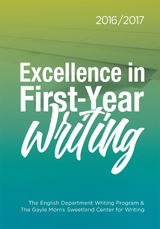 Excellence in First-Year Writing 2016/2017
Dana Nichols, editor
Michigan Publishing, 2017 Every day, students at the University of Michigan work hard to develop their skills as writers. Every winter, we have a chance to sample the fruits of this labor as we select winners for the first-year writing prize. The English Department Writing Program and the Sweetland Center for Writing established a first-year writing prize in 2010. With generous support from the Sweetland Center for Writing, Andrew Feinberg and Stacia Smith (both of whom earned English degrees from the University of Michigan), and the Granader Family, we have developed a tradition of honoring students who produce writing of exceptional quality. In this collection, we share the writing of prize-winning students so that other writers may learn from, and feel inspired by, their examples. The featured essays illustrate how writers formulate compelling questions, engage in dialogue with other thinkers, incorporate persuasive and illuminating evidence, express powerful and poetic insights, and participate in meaningful conversations. We are equally grateful to the many students who submitted essays for these writing prizes and the many instructors who encouraged and supported them. As writing teachers, we relish the opportunity to learn from the challenging questions, intellectual energy, creativity, and dedication that our students and their teachers bring to our classrooms. We hope that you will gain as much pleasure as we have from reading the writing contained in this volume.
 Excellence in First-Year Writing 2017/2018
Edited by Dana Nichols
Michigan Publishing, 2018 Every day, students at the University of Michigan work hard to develop their skills as writers. Every winter, we have a chance to sample the fruits of this labor as we select winners for the first-year writing prize. The English Department Writing Program and the Sweetland Center for Writing established a first-year writing prize in 2010. With generous support from the Sweetland Center for Writing, Andrew Feinberg and Stacia Smith (both of whom earned English degrees from the University of Michigan), and the Granader Family, we have developed a tradition of honoring students who produce writing of exceptional quality. In this collection, we share the writing of prize-winning students so that other writers may learn from, and feel inspired by, their examples. The featured essays illustrate how writers formulate compelling questions, engage in dialogue with other thinkers, incorporate persuasive and illuminating evidence, express powerful and poetic insights, and participate in meaningful conversations. We are equally grateful to the many students who submitted essays for these writing prizes and the many instructors who encouraged and supported them. As writing teachers, we relish the opportunity to learn from the challenging questions, intellectual energy, creativity, and dedication that our students and their teachers bring to our classrooms. We hope that you will gain as much pleasure as we have from reading the writing contained in this volume.
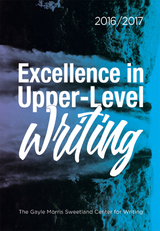 Excellence in Upper-Level Writing 2016/2017
Dana Nichols, editor
Michigan Publishing, 2017 Ask any professional, business person, or employer about one of the most important qualifications for college-educated workers, and the answer will be nearly universal: the ability to write well. The Upper-Level Writing Requirement (ULWR) was established to enable undergraduates in the College of Literature, Science, and the Arts to develop their capacities as writers. Originally designed in 1978 to help students “understand and communicate effectively the central concepts, approaches, and materials of their discipline,” the ULWR supports a slightly different goal in today’s more interdisciplinary context. A significant percentage of students now have more than one major or fulfill the ULWR outside of their majors. Likewise, many faculty members are increasingly concerned with preparing students to write for various professional and public audiences as well as for discipline-based ones. However, whether students fulfill the ULWR within or outside of their majors or write for audiences within or outside of the academy, they are held to the same standards of effective writing. This collection demonstrates the continuing value of the ULWR. Courses like the ones in which students produced these essays create contexts where students meet the expectations of the ULWR and can push beyond them to an even more impressive level of accomplishment. While the specifics of what counts as evidence and how one makes a convincing argument vary across the essays included here, each one embodies qualities that mark effective writing. The authors deal with a wide variety of topics, but in every case they combine deep understanding of a specific area with excellent prose. They take risks and adhere to conventions; they synthesize complex ideas and provide rich detail; they exert intellectual independence and respect disciplinary conventions, from creative nonfiction in the humanities to empirical research in the sciences. We have been honoring students for outstanding writing in ULWR courses since 2010, but since 2014, thanks to a generous gift from the Granader Family, the prizes are more substantial. We are grateful to the Granaders for choosing to recognize student writing in this way. This collection is another form of recognition for the award-winning students. By publishing this student writing both online and in hard copy we make it available as a model and as a source of inspiration for others. Talented and committed as they are, these students represented here did not become award-winners entirely on their own. Each of them benefited from well-designed assignments, careful reading, and suggestions for revision from the instructors who nominated them. The instructors’ introductions for each selection provide a window into student learning as well as into the specific dimensions of each student’s achievements.
 Excellence in Upper-Level Writing 2017/2018
Edited by Dana Nichols
Michigan Publishing, 2018 Ask any professional, business person, or employer about one of the most important qualifications for college-educated workers, and the answer will be nearly universal: the ability to write well. The Upper-Level Writing Requirement (ULWR) was established to enable undergraduates in the College of Literature, Science, and the Arts to develop their capacities as writers. Originally designed in 1978 to help students "understand and communicate effectively the central concepts, approaches, and materials of their discipline," the ULWR supports a slightly different goal in today's more interdisciplinary context. A significant percentage of students now have more than one major or fulfill the ULWR outside of their majors. Likewise, many faculty members are increasingly concerned with preparing students to write for various professional and public audiences as well as for discipline-based ones. However, whether students fulfill the ULWR within or outside of their majors or write for audiences within or outside of the academy, they are held to the same standards of effective writing. This collection demonstrates the continuing value of the ULWR. Courses like the ones in which students produced these essays create contexts where students meet the expectations of the ULWR and can push beyond them to an even more impressive level of accomplishment. While the specifics of what counts as evidence and how one makes a convincing argument vary across the essays included here, each one embodies qualities that mark effective writing. The authors deal with a wide variety of topics, but in every case they combine deep understanding of a specific area with excellent prose. They take risks and adhere to conventions; they synthesize complex ideas and provide rich detail; they exert intellectual independence and respect disciplinary conventions, from creative nonfiction in the humanities to empirical research in the sciences. We have been honoring students for outstanding writing in ULWR courses since 2010, but since 2014, thanks to a generous gift from the Granader Family, the prizes are more substantial. We are grateful to the Granaders for choosing to recognize student writing in this way. This collection is another form of recognition for the award-winning students. By publishing this student writing both online and in hard copy we make it available as a model and as a source of inspiration for others. Talented and committed as they are, these students represented here did not become award-winners entirely on their own. Each of them benefited from well-designed assignments, careful reading, and suggestions for revision from the instructors who nominated them. The instructors' introductions for each selection provide a window into student learning as well as into the specific dimensions of each student's achievements.
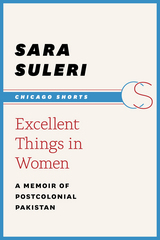 Excellent Things in Women: A Memoir of Postcolonial Pakistan
Sara Suleri Goodyear
University of Chicago Press, 1989 Sometimes, only the most heartbreaking memories possess the capacity—in their elegiac immediacy—to take our breath away. With Excellent Things in Women, Sara Suleri offers the reader a delicately wrought memoir of life in postcolonial Pakistan. Suleri intertwines the violent history of Pakistan's independence with her own intimate experiences—relating the tumult of growing up female during a time of fierce change in the Middle East in the 1960s and ’70s. In the two selections presented here, “Excellent Things in Women” and “Meatless Days,” we watch as Suleri re-encounters the relationships that inform her voyage from adolescence to womanhood—with her Welsh mother; her Pakistani father, prominent political journalist Z. A. Suleri; and her tenacious grandmother, Dadi, along with her five siblings—as she comes to terms with the difficulties of growing up and her own complicated passage to the West.
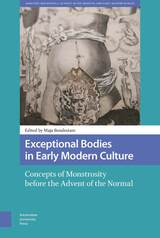 Exceptional Bodies in Early Modern Culture: Concepts of Monstrosity Before the Advent of the Normal
Maja Bondestam
Amsterdam University Press, 2021 Drawing on a rich array of textual and visual primary sources, including medicine, satires, play scripts, dictionaries, natural philosophy, and texts on collecting wonders, this book provides a fresh perspective on monstrosity in early modern European culture. The essays explore how exceptional bodies challenged social, religious, sexual and natural structures and hierarchies in the sixteenth, seventeenth and early eighteenth centuries and contributed to its knowledge, moral and emotional repertoire. Prodigious births, maternal imagination, hermaphrodites, collections of extraordinary things, powerful women, disabilities, controversial exercise, shapeshifting phenomena and hybrids are examined in a period before all varieties and differences became normalized to a homogenous standard. The historicizing of exceptional bodies is central in the volume since it expands our understanding of early modern culture and deepens our knowledge of its specific ways of conceptualizing singularities, rare examples, paradoxes, rules and conventions in nature and society.
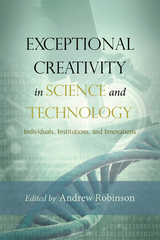 Exceptional Creativity in Science and Technology: Individuals, Institutions, and Innovations
Andrew Robinson
Templeton Press, 2013 In the evolution of science and technology, laws governing exceptional creativity and innovation have yet to be discovered. In his influential study The Structure of Scientific Revolutions, the historian Thomas Kuhn noted that the final stage in a scientific breakthrough such as Albert Einstein’s theory of relativity—the most crucial step—was “inscrutable.” The same is still true half a century later. Yet, there has been considerable progress in understanding many stages and facets of exceptional creativity and innovation. In Exceptional Creativity in Science and Technology, editor Andrew Robinson gathers diverse contributors to explore this progress. This new collection arises from a symposium with the same title held at the Institute for Advanced Study (IAS) in Princeton. Organized by the John Templeton Foundation, the symposium had the late distinguished doctor and geneticist Baruch S. Blumberg as its chair. At the same time, its IAS host was the well-known physicist Freeman J. Dyson—both of whom have contributed chapters to the book. In addition to scientists, engineers, and an inventor, the book’s fifteen contributors include an economist, entrepreneurs, historians, and sociologists, all working at leading institutions, including Bell Laboratories, Microsoft Research, Oxford University, Princeton University, and Stanford University. Each contributor brings a unique perspective to the relationships between exceptional scientific creativity and innovation by individuals and institutions. The diverse list of disciplines covered, the high-profile contributors (including two Nobel laureates), and their fascinating insights into this overarching question—how exactly do we make breakthroughs?—will make this collection of interest to anyone involved with the creative process in any context. Still, it will especially appeal to readers in scientific and technological fields.
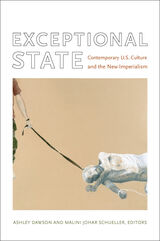 Exceptional State: Contemporary U.S. Culture and the New Imperialism
Ashley Dawson and Malini Johar Schueller, eds.
Duke University Press, 2007 Exceptional State analyzes the nexus of culture and contemporary manifestations of U.S. imperialism. The contributors, established and emerging cultural studies scholars, define culture broadly to include a range of media, literature, and political discourse. They do not posit September 11, 2001 as the beginning of U.S. belligerence and authoritarianism at home and abroad, but they do provide context for understanding U.S. responses to and uses of that event. Taken together, the essays stress both the continuities and discontinuities embodied in a present-day U.S. imperialism constituted through expressions of millennialism, exceptionalism, technological might, and visions of world dominance. The contributors address a range of topics, paying particular attention to the dynamics of gender and race. Their essays include a surprising reading of the ostensibly liberal movies Wag the Dog and Three Kings, an exploration of the rhetoric surrounding the plan to remake the military into a high-tech force less dependent on human bodies, a look at the significance of the popular Left Behind series of novels, and an interpretation of the Abu Ghraib prison photos. They scrutinize the national narrative created to justify the U.S. invasions of Afghanistan and Iraq, the ways that women in those countries have responded to the invasions, the contradictions underlying calls for U.S. humanitarian interventions, and the role of Africa in the U.S. imperial imagination. The volume concludes on a hopeful note, with a look at an emerging anti-imperialist public sphere. Contributors. Omar Dahbour, Ashley Dawson, Cynthia Enloe, Melani McAlister, Christian Parenti, Donald E. Pease, John Carlos Rowe, Malini Johar Schueller, Harilaos Stecopoulos
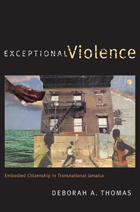 Exceptional Violence: Embodied Citizenship in Transnational Jamaica
Deborah A. Thomas
Duke University Press, 2011 Exceptional Violence is a sophisticated examination of postcolonial state formation in the Caribbean, considered across time and space, from the period of imperial New World expansion to the contemporary neoliberal era, and from neighborhood dynamics in Kingston to transnational socioeconomic and political fields. Deborah A. Thomas takes as her immediate focus violence in Jamaica and representations of that violence as they circulate within the country and abroad. Through an analysis encompassing Kingston communities, Jamaica’s national media, works of popular culture, notions of respectability, practices of punishment and discipline during slavery, the effects of intensified migration, and Jamaica’s national cultural policy, Thomas develops several arguments. Violence in Jamaica is the complicated result of a structural history of colonialism and underdevelopment, not a cultural characteristic passed from one generation to the next. Citizenship is embodied; scholars must be attentive to how race, gender, and sexuality have been made to matter over time. Suggesting that anthropologists in the United States should engage more deeply with history and political economy, Thomas mobilizes a concept of reparations as a framework for thinking, a rubric useful in its emphasis on structural and historical lineages.
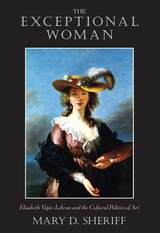 The Exceptional Woman: Elisabeth Vigee-Lebrun and the Cultural Politics of Art
Mary D. Sheriff
University of Chicago Press, 1996 Elisabeth Vigée-Lebrun (1755-1842) was an enormously successful painter, a favorite portraitist of Marie-Antoinette, and one of the few women accepted into the Royal Academy of Painting and Sculpture. In accounts of her role as an artist, she was simultaneously flattered as a charming woman and vilified as monstrously unfeminine.
In The Exceptional Woman, Mary D. Sheriff uses Vigée-Lebrun's career to explore the contradictory position of "woman-artist" in the moral, philosophical, professional, and medical debates about women in eighteenth-century France. Paying particular attention to painted and textual self-portraits, Sheriff shows how Vigée-Lebrun's images and memoirs undermined the assumptions about "woman" and the strictures imposed on women.
Engaging ancien-régime philosophy, as well as modern feminism, psychoanalysis, literary theory, and art criticism, Sheriff's interpretations of Vigée-Lebrun's paintings challenge us to rethink the work and the world of this controversial woman artist.
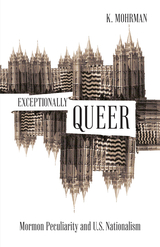 Exceptionally Queer: Mormon Peculiarity and U.S. Nationalism
K. Mohrman
University of Minnesota Press, 2022 How perceptions of Mormonism from 1830 to the present reveal the exclusionary, racialized practices of the U.S. nation-state
Are Mormons really so weird? Are they potentially queer? These questions occupy the heart of this powerful rethinking of Mormonism and its place in U.S. history, culture, and politics. K. Mohrman argues that Mormon peculiarity is not inherent to the Latter-day Saint faith tradition, as is often assumed, but rather a potent expression of U.S. exceptionalism. Exceptionally Queer scrutinizes the history of Mormonism starting with its inception in the early 1830s and continuing to the present. Drawing on a wide range of historical texts and moments—from nineteenth-century battles over Mormon plural marriage; to the LDS Church’s emphases on “individual responsibility” and “family values”; to mainstream media’s coverage of the LDS Church’s racist exclusion of Black priesthood holders, its Native assimilation programs, and vehement opposition to the Equal Rights Amendment; and to much more recent legal and cultural battles over same-sex marriage and on-screen Mormon polygamy—Exceptionally Queer evaluates how Mormonism has been used to motivate and rationalize the biased, exclusionary, and colonialist policies and practices of the U.S. nation-state. Mohrman explains that debates over Mormonism both drew on and shaped racial discourses and, in so doing, delineated the boundaries of whiteness and national belonging, largely through the consolidation of (hetero)normative ideas of sex, marriage, family, and economy. Ultimately, the author shows how discussions of Mormonism in this country have been and continue to be central to ideas of what it means to be American.
The Exchange and Other Stories
Yuri Trifonov
Northwestern University Press, 2002 Yury Trifonov took a turn toward the controversial, and a leap toward greatness, with the publication of the two novellas included in this collection. "The Exchange" and "The Long Goodbye" depict the complex dilemmas and compromises of Russian life after World War II. These works, along with the short stories "Games at Dusk" and "A Short Stay in the Torture Chamber," detail the moral and spiritual decline in Russia that resulted from the growing distance between the theoretical idealism of the Soviet state and the actual materialism and careerism that increasingly marked society.
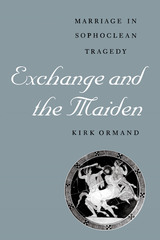 Exchange and the Maiden: Marriage in Sophoclean Tragedy
By Kirk Ormand
University of Texas Press, 1999 Marriage is a central concern in five of the seven extant plays of the Greek tragedian Sophocles. In this pathfinding study, Kirk Ormand delves into the ways in which these plays represent and problematize marriage, thus offering insights into how Athenians thought about the institution of marriage. Ormand takes a two-fold approach. He first explores the legal and economic underpinnings of Athenian marriage, an institution designed to guarantee the legitimate continuation of patrilineal households. He then shows how Sophocles' plays Trachiniae, Electra, Antigone, Ajax, and Oedipus Tyrannus both reinforce and critique this ideology by representing marriage as a homosocial exchange between men, in which women are objects who may attempt—but always fail—to become self-acting subjects. These fresh readings provide the first systematic study of marriage in Sophocles. They draw important connections between drama and marriage as rituals concerned with controlling potentially disruptive female subjectivities.
 Exchange Depreciation: Its Theory and Its History, 1931–35, with Some Consideration of Related Domestic Policies
S. E. Harris
Harvard University Press In this volume Professor Harris studies the epidemic of exchange depreciation that since 1931 has directly affected almost the entire world, and attempts to answer the question whether it has done the world more good than harm. Part I is a discussion of important theoretical issues raised by current experiences with exchange depreciation. In Part II Professor Harris makes the most thorough statistical study of the relation of exchange depreciation to prices, trade, and production that has yet been made. Part III is more than a study of exchange depreciation in the United States: it is also a thorough study of the legislation and policies of the Roosevelt Administration, domestic policies being discussed in their relation to exchange depreciation. Finally, the British episode receives attention in Part IV, a separate chapter being devoted to the British Exchange Equalisation Fund and one to the relation of depreciation to British trade, production, and prices.
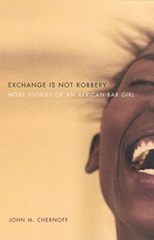 Exchange Is Not Robbery: More Stories of an African Bar Girl
John M. Chernoff
University of Chicago Press, 2004 While living in West Africa in the 1970s, John Chernoff recorded the stories of "Hawa," a spirited and brilliant but uneducated woman whose insistence on being respected and treated fairly propelled her, ironically, into a life of marginality and luck as an "ashawo," or bar girl. Rejecting traditional marriage options and cut off from family support, she is like many women in Africa who come to depend on the help they receive from one another, from boyfriends, and from the men they meet in bars and nightclubs. Refusing to see herself as a victim, Hawa embraces the freedom her lifestyle permits and seeks the broadest experience available to her.
In Exchange Is Not Robbery and its predecessor, Hustling Is Not Stealing, a chronicle of exploitation is transformed by verbal art into an ebullient comedy. In Hustling Is Not Stealing, Hawa is a playful warrior struggling against circumstances in Ghana and Togo. In Exchange Is Not Robbery, Hawa returns to her native Burkina Faso, where she achieves greater control over her life but faces new difficulties. As a woman making sacrifices to live independently, Hawa sees her own situation become more complex as she confronts an atmosphere in Burkina Faso that is in some ways more challenging than the one she left behind, and the moral ambiguities of her life begin to intensify.
Combining elements of folklore and memoir, Hawa's stories portray the diverse social landscape of West Africa. Individually the anecdotes can be funny, shocking, or poignant; assembled together they offer a sweeping critical and satirical vision.
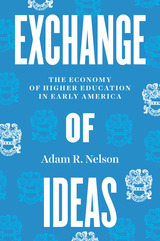 Exchange of Ideas: The Economy of Higher Education in Early America
Adam R. Nelson
University of Chicago Press, 2023 The first volume of an ambitious new economic history of American higher education.
Exchange of Ideas launches a breathtakingly ambitious new economic history of American higher education. In this volume, Adam R. Nelson focuses on the early republic, explaining how knowledge itself became a commodity, as useful ideas became salable goods and American colleges were drawn into transatlantic commercial relations. American scholars might once have imagined that higher education could sit beyond the sphere of market activity—that intellectual exchange could transcend vulgar consumerism—but already by the end of the eighteenth century, they saw how ideas could be factored into the nation’s balance of trade. Moreover, they concluded that it was the function of colleges to oversee the complex process whereby knowledge could be priced and purchased. The history of capitalism and the history of higher education, Nelson reveals, are intimately intertwined—which raises a host of important and strikingly urgent questions. How do we understand knowledge and education as commercial goods? Who should pay for them? And, fundamentally, what is the optimal system of higher education in a capitalist democracy?
Exchange Rate Theory and Practice
Edited by John F. Bilson and Richard C. Marston
University of Chicago Press, 1984 This volume grew out of a National Bureau of Economic Research conference on exchange rates held in Bellagio, Italy, in 1982. In it, the world's most respected international monetary economists discuss three significant new views on the economics of exchange rates - Rudiger Dornbusch's overshooting model, Jacob Frenkel's and Michael Mussa's asset market variants, and Pentti Kouri's current account/portfolio approach. Their papers test these views with evidence from empirical studies and analyze a number of exchange rate policies in use today, including those of the European Monetary System.
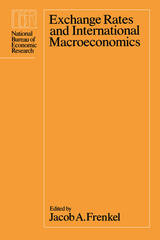 Exchange Rates and International Macroeconomics
Edited by Jacob A. Frenkel
University of Chicago Press, 1983 This volume, presenting some of the finest new research on exchange rates and international macroeconomics, contains papers and critical commentary by thirty-two leading economists. Taken together, these papers provide sound evidence about the effects of real and monetary factors on exchange rates and extend the analyses of exchange rates and international macroeconomics by outlining the kinds of behavior and institutional arrangements that can be incorporated into such analyses.
Both empirical and theoretical research are represented, and the contributors analyze such issues as the performance of various models of exchange rate determination, the role of risk and speculation in the forward market for foreign exchange, the rational expectations hypothesis in such markets, the performance of monetary policy in ten industrial countries, the role that labor market contracts play in exchange rate policies, the effect of he oil shocks on the evolution of exchange rates, and the output cost of bringing down inflation in the open economy.
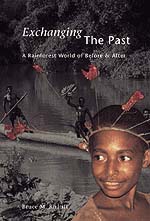 Exchanging the Past: A Rainforest World of Before and After
Bruce M. Knauft
University of Chicago Press, 2002 Twenty years ago, the Gebusi of the lowland Papua New Guinea rainforest had one of the highest homicide rates in the world. Bruce M. Knauft found then that the killings stemmed from violent scapegoating of suspected sorcerers. But by the time he returned in 1998, homicide rates had plummeted, and Gebusi had largely disavowed vengeance against sorcerers in favor of modern schools, discos, markets, and Christianity.
In this book, Knauft explores the Gebusi's encounter with modern institutions and highlights what their experience tells us more generally about the interaction between local peoples and global forces. As desire for material goods grew among Gebusi, Knauft shows that they became more accepting of and subordinated by Christian churches, community schools,and government officials in their attempt to benefit from them—a process Knauft terms "recessive agency." But the Gebusi also respond actively to modernity, creating new forms of feasting, performance, and music that meld traditional practices with Western ones, all of which Knauft documents in this fascinating study.
Exchanging Writing, Exchanging Cultures: Lessons in School Reform from the United States and Great Britain
Sarah W. Freedman
Harvard University Press, 1994 What can teachers in British and American inner-city schools learn from each other about literacy training? To explore this question, Sarah Warshauer Freedman and her British colleagues set up a writing exchange that matched classes from four middle and high schools in the San Francisco Bay area with their London equivalents.
Exchanging Writing, Exchanging Cultures offers concrete lessons to school reformers, policymakers, and classroom teachers about the value and effectiveness of different approaches to teaching writing. Freedman goes beyond the specific subject matter of this study, looking anew at Vygotsky's and Bakhtin's theories of social interaction and addressing the larger questions of the relationship between culture and education.
 Excited Delirium: Race, Police Violence, and the Invention of a Disease
Aisha M. Beliso-De Jesús
Duke University Press, 2024 In 1980, Charles Wetli---a Miami-based medical examiner and self-proclaimed “cult expert” of Afro-Caribbean religions---identified what he called “excited delirium syndrome.” Soon, medical examiners began using the syndrome regularly to describe the deaths of Black men and women during interactions with police. Police and medical examiners claimed that Black people with so-called excited delirium exhibited superhuman strength induced from narcotics abuse. It was fatal heart failure that killed them, examiners said, not forceful police restraints. In Excited Delirium, Aisha M. Beliso-De Jesús examines this fabricated medical diagnosis and its use to justify and erase police violence against Black and Brown communities. Exposing excited delirium syndrome’s flawed diagnostic criteria, she outlines its inextricable ties to the criminalization of Afro-Latiné religions. Beliso-De Jesús demonstrates that it is yet a further example of the systemic racism that pervades law enforcement in which the culpability for state violence is shifted from the state onto its victims. In so doing, she furthers understanding of the complex layers of medicalized state-sanctioned violence against people of color in the United States.
The Exciting Life of Being a Woman
Amelia Lee
Intellect Books, 2012 The Exciting Life of Being a Woman is the feminist survival manual you wish you had read as a teenager. It is written by Feminist Webs, a cross-generational youth project for girls and young women based in Manchester, UK. Drawing on the history, practices and activities of Feminist Webbers, The Exciting Life of Being a Woman provides inspiration for women of all ages to live their life in creative and empowered ways. It includes illustrations, comics, youth work activities, personal writing and much more.
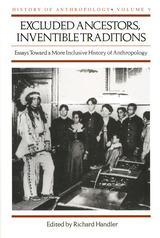 Excluded Ancestors, Inventible Traditions: Essays Toward a More Inclusive History of Anthropology
Edited by Richard Handler
University of Wisconsin Press, 2015 History-making can be used both to bolster and to contest the legitimacy of established institutions and canons. Excluded Ancestors, Inventible Traditions seeks to widen the anthropological past and, in doing so, to invigorate contemporary anthropological practice. In the past decade, anthropologists have become increasingly aware of the ways in which participation in professional anthropology has depended and continues to depend on categorical boundaries of race, class, gender, citizenship, institutional and disciplinary affiliation, and English-language proficiency. Historians of anthropology play a crucial role interrogating such boundaries; as they do, they make newly available the work of anthropologists who have been ignored.
Excluded Ancestors, Inventible Traditions focuses on little-known scholars who contributed to the anthropological work of their time, such as John William Jackson, the members of the Hampton Folk-Lore Society, Charlotte Gower Chapman, and Lucie Varga. In addition, essays on Marius Barbeau and Sol Tax present figures who were centrally located in the anthropologies of their day. A final essay analyzes notions of "the canon" and considers the place of a classic ethnographic area, highland New Guinea, in anthropological canon-formation.
Exclusion and Engagement: Social Policy in Latin America
Edited by Christopher Abel and Colin M. Lewis
University of London Press, 2002 This collection offers a reappraisal of social policy in response to the scale of the challenges confronting Latin America. Divided into four sections --Concepts, Models and Practice; Health and Social Security; Education; and Household and Community --the book explores the functions of social policy and the prospects of it's performing a new and more dynamic role. The authors place contemporary social policy in historical perspective, study the connection between growth and welfare, and consider the efficacy of the state in the social sphere from both macro and micro perspectives. Underpinning the collection are issues relating to the question of the social contract between state and citizen and how the exercise of citizenship connects society and state.
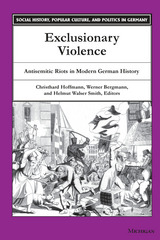 Exclusionary Violence: Antisemitic Riots in Modern German History
Christhard Hoffmann, Werner Bergmann, and Helmut Walser Smith, Editors
University of Michigan Press, 2002 Whereas a large body of scholarly literature exists on German antisemitism in general, pre-Nazi histories of violence against Jews in the nineteenth and twentieth centuries have been widely neglected. This coherent and well-focused collection of essays is the first comprehensive work in any language dealing with antisemitic pogroms in modern German history from the Hep Hep riots of 1819 to the Reichskristallnacht. In the Western mind, outbursts of collective violence against Jews have been largely identified with Tzarist Russia and the medieval crusade massacres. However, by narrating pogroms as archaic, historians have overlooked their significance to the development of modern antisemitism in Germany and Europe as well as the reasons for its continued presence in the contemporary world. The evidence presented in this volume suggests that acts of exclusionary violence were not dead-end streets of futile protest. Rather, they were rehearsals for new kinds of destruction. The integration of various perspectives and the close cooperation of scholars from different disciplines is a major achievement of this volume, which will be of interest to advanced undergraduates, graduate students, academics and the general reader in a variety of disciplines, including German studies, Jewish studies, Holocaust and genocide studies, ethnic relations, history, and the social sciences in general.
 Exclusions
Noah Falck
Tupelo Press, 2020 What happens when a central part of life as we know it does not exist? Noah Falck’s latest collection answers this question in a playfully gloomy way that reveals the strange edges of our reality. Anyone who has experienced that rug-pulling sensation of change, of strangeness, will relate to Noah Falk’s Exclusions. Each lyric poem “excludes” a common subject, including topics such as fiction, modern technology, answers, government, and romance. By setting these subjects against a backdrop of obscurity and strangeness, Falck skillfully keeps readers invested and off-balance. Exclusions brings readers into a world where “the wind is nothing more than a brilliant collection of sighs” and “the sun flattens into a sort of messy bruise over the lake.” Even excluding many of the things we take for granted, Falck’s lyric poetry includes so much: death, smoke, shadows, sadness, history. This collection will leave readers with a changed perspective on what is necessary, and how to deal with immense change. A 2020 Believer Book Awards Finalist, Exclusions has been praised for its ability to “[keep readers] off balance, stumbling forward, and absolutely alive with both the inventive possibilities of lyric poetry and that rare experience of watching the genre redefine itself in a pair of this art’s most capable hands.” This is a genre-defining book of poetry that allows us to look into the past, present, and future to understand “the foundations of sadness beginning with the needs of children.”
 Exclusive Revolutionaries: Liberal Politics, Social Experience, and National Identity in the Austrian Empire, 1848-1914
Pieter M. Judson
University of Michigan Press, 1996 Exclusive Revolutionaries traces the development of German liberal and later nationalist political culture in imperial Austria from the revolutions of 1848 to the outbreak of World War I. Drawing on archival research from several regions of the former Habsburg Monarchy, Pieter M. Judson provides a clear, chronological political narrative that demonstrates the continuing influence of liberal ideas and values well after the defeat of liberal political parties.
In the mid-1800s, Judson argues, German liberal activists built an effective political movement whose ideology was rooted in its members' social experience in voluntary associations. The liberals were committed to the creation of a market economy based on personal property rights, to a society based on the values of individual self-improvement and personal respectability, and to a fundamental distinction between active and passive citizenship. They were determined to achieve a harmonious community of free peoples, in which personal enlightenment would bring an end to the divisive influence of localism, ethnicity, religion, and feudal social hierarchy.
Yet after 1880, as newer, more radical mass political movements threatened their political fortunes, the liberals forged a German nationalist politics based increasingly on ethnic identity. Their emphasis on national identity became a way for former liberals to hold together an increasingly diverse coalition of German speakers who had little in common outside of their shared language. Only "Germanness" bridged the dangerous gulf between social classes. This nationalism helped the liberals to compete for power in the multinational, multicultural Austrian Empire down to 1914, but it left a legacy of nationalist extremism and tolerance of anti-Semitism that continues to influence political cultures in the former lands of the Habsburg Monarchy today.
Exclusive Revolutionaries will interest social and cultural historians of nineteenth-century Europe, and of Germany and Central Europe in particular.
Pieter M. Judson is Professor of History, Swarthmore College. He is the recipient of a fellowship from the John Simon Guggenheim Foundation.
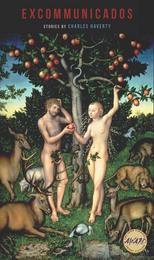 Excommunicados
Charles Haverty
University of Iowa Press, 2015 By turns haunting, hilarious, and heartbreaking, Charles Haverty’s debut collection charts the journeys of men, women, and children cast out of familiar territory into emotional terra incognita where people and things are rarely what they seem. These twelve stories are populated with ex-nuns and Freedom Riders, Chaucer scholars and strippers, out-of-work comedy writers and presidents, navigating their way through bedrooms and emergency rooms, backyard burial parties and airplane crash sites, the Piazza San Marco and the post-apocalyptic suburbs of Boston.
A sixteen-year-old boy unearths grisly evidence of his genteel grandfather’s racist past. At his sister’s booze-soaked destination wedding, a recovering alcoholic English professor is finagled into ghostwriting their unreliable father’s nuptial toast. A small town lawyer’s Edenic existence is jeopardized when his wife’s younger brother is arrested for a rash of local burglaries. In the wake of her daughter’s brush with disaster in the Haiti earthquake, a mother finds herself drawn down a dark neighborhood sidewalk toward what might or might not be a dead body. And in the title story—the first of three linked stories—a pious altar boy confronts the twin mysteries of sex and death through the auspices of a classmate’s divorced mother.
There are secrets at the center of each of these daring and original stories—secrets that separate these characters from one another but grow in the mind and the heart, connecting them with all of us.
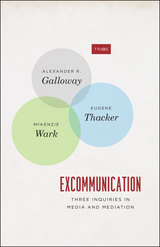 Excommunication: Three Inquiries in Media and Mediation
Alexander R. Galloway, Eugene Thacker, and McKenzie Wark
University of Chicago Press, 2013 Always connect—that is the imperative of today’s media. But what about those moments when media cease to function properly, when messages go beyond the sender and receiver to become excluded from the world of communication itself—those messages that state: “There will be no more messages”? In this book, Alexander R. Galloway, Eugene Thacker, and McKenzie Wark turn our usual understanding of media and mediation on its head by arguing that these moments reveal the ways the impossibility of communication is integral to communication itself—instances they call excommunication. In three linked essays, Excommunication pursues this elusive topic by looking at mediation in the face of banishment, exclusion, and heresy, and by contemplating the possibilities of communication with the great beyond. First, Galloway proposes an original theory of mediation based on classical literature and philosophy, using Hermes, Iris, and the Furies to map out three of the most prevalent modes of mediation today—mediation as exchange, as illumination, and as network. Then, Thacker goes boldly beyond Galloway’s classification scheme by examining the concept of excommunication through the secret link between the modern horror genre and medieval mysticism. Charting a trajectory of examples from H. P. Lovecraft to Meister Eckhart, Thacker explores those instances when one communicates or connects with the inaccessible, dubbing such modes of mediation “haunted” or “weird” to underscore their inaccessibility. Finally, Wark evokes the poetics of the infuriated swarm as a queer politics of heresy that deviates from both media theory and the traditional left. He posits a critical theory that celebrates heresy and that is distinct from those that now venerate Saint Paul. Reexamining commonplace definitions of media, mediation, and communication, Excommunication offers a glimpse into the realm of the nonhuman to find a theory of mediation adequate to our present condition.
 Excursions
Michael Jackson
Duke University Press, 2007 A village in Sierra Leone. A refugee trail over the Pyrenees in French Catalonia. A historic copper mine in Sweden. The Shuf mountains in Lebanon. The Swiss Alps. The heart of the West African diaspora in southeast London. The anthropologist Michael Jackson makes his sojourns to each of these far-flung locations, and to his native New Zealand, occasions for exploring the contradictions and predicaments of social existence. He calls his explorations “excursions” not only because each involved breaking with settled routines and certainties, but because the image of an excursion suggests that thought is always on the way, the thinker a journeyman whose views are perpetually tested by encounters with others. Throughout Excursions, Jackson emphasizes the need for preconceptions and conventional mindsets to be replaced by the kind of open-minded critical engagement with the world that is the hallmark of cultural anthropology. Focusing on the struggles and quandaries of everyday life, Jackson touches on matters at the core of anthropology—the state, violence, exile and belonging, labor, indigenous rights, narrative, power, home, and history. He is particularly interested in the gaps that characterize human existence, such as those between insularity and openness, between the things over which we have some control and the things over which we have none, and between ourselves and others as we talk past each other, missing each others’ meanings. Urging a recognition of the limits to which human existence can be explained in terms of cause and effect, he suggests that knowing why things happen may ultimately be less important than trying to understand how people endure in the face of hardship.
 Executing Democracy: Volume One: Capital Punishment & the Making of America, 1683-1807
Stephen J. Hartnett
Michigan State University Press, 2010 Executing Democracy: Capital Punishment & the Making of America, 1683-1807 is the first volume of a rhetorical history of public debates about crime, violence, and capital punishment in America. This examination begins in 1683, when William Penn first struggled to govern the rowdy indentured servants of Philadelphia, and continues up until 1807, when the Federalists sought to impose law-and-order upon the New Republic.
This volume offers a lively historical overview of how crime, violence, and capital punishment influenced the settling of the New World, the American Revolution, and the frantic post-war political scrambling to establish norms that would govern the new republic.
By presenting a macro-historical overview, and by filling the arguments with voices from different political camps and communicative genres, Hartnett provides readers with fresh perspectives for understanding the centrality of public debates about capital punishment to the history of American democracy.
 Executing Democracy: Volume Two: Capital Punishment and the Making of America, 1835-1843
Stephen Hartnett
Michigan State University Press, 2024 This eye-opening and well-researched companion to the first volume of Executing Democracy enters the death-penalty discussion during the debates of 1835 and 1843, when pro-death penalty Calvinist minister George Barrell Cheever faced off against abolitionist magazine editor John O’Sullivan. In contrast to the macro-historical overview presented in volume 1, volume 2 provides micro-historical case studies, using these debates as springboards into the discussion of the death penalty in America at large. Incorporating a wide range of sources, including political poems, newspaper editorials, and warring manifestos, this second volume highlights a variety of perspectives, thus demonstrating the centrality of public debates about crime, violence, and punishment to the history of American democracy. Hartnett’s insightful assessment bears witness to a complex national discussion about the political, metaphysical, and cultural significance of the death penalty.
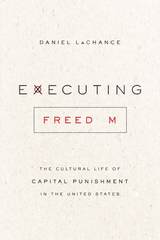 Executing Freedom: The Cultural Life of Capital Punishment in the United States
Daniel LaChance
University of Chicago Press, 2016 In the mid-1990s, as public trust in big government was near an all-time low, 80% of Americans told Gallup that they supported the death penalty. Why did people who didn’t trust government to regulate the economy or provide daily services nonetheless believe that it should have the power to put its citizens to death?
That question is at the heart of Executing Freedom, a powerful, wide-ranging examination of the place of the death penalty in American culture and how it has changed over the years. Drawing on an array of sources, including congressional hearings and campaign speeches, true crime classics like In Cold Blood, and films like Dead Man Walking, Daniel LaChance shows how attitudes toward the death penalty have reflected broader shifts in Americans’ thinking about the relationship between the individual and the state. Emerging from the height of 1970s disillusion, the simplicity and moral power of the death penalty became a potent symbol for many Americans of what government could do—and LaChance argues, fascinatingly, that it’s the very failure of capital punishment to live up to that mythology that could prove its eventual undoing in the United States.
The Execution of Private Slovik
William Bradford Huie
Westholme Publishing, 2004 Publisher's Note: A new edition of this book is available, ISBN 978-1-59416-337-1.
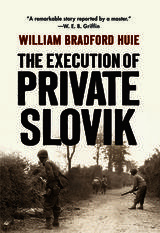 The Execution of Private Slovik
William Bradford Huie
Westholme Publishing, 2020 Seventy-Five Years Ago, the Last American Soldier Who Paid the Ultimate Price for Desertion
A New Edition of the Acclaimed Investigative Story In August 1944, a drab convoy of raw recruits destined to join the 28th Division lumbered along a windy French road strewn with dead animals, shattered bodies, and burning equipment. One of those draftees was 24-year-old Eddie Slovik, a petty thief from Detroit who had spent his youth in and out of reform schools. Eddie's luck had recently changed, however, with a steady factory job and marriage to a beautiful girl who gave Eddie hope and security for the first time in his life. But their honeymoon—like that of many other wartime newlyweds—was interrupted by the call to service. The convoy came under intense artillery fire, and in the confusion Slovik became separated from his unit. He joined a Canadian outfit and traveled with them before finally reporting to the 28th Division. He carried a rifle but no ammunition. He was assigned to a platoon but walked away. Refusing to kill, Slovik was arrested, court martialed, and condemned to death. Hundreds of soldiers were tried for desertion during World War II and sentenced to die, but only Eddie Slovik paid the price, supposedly as a deterrent, yet word of the nature of his death was never officially released to the public. In The Execution of Private Slovik, considered to be among the best investigative books ever written, journalist and author William Bradford Huie reconstructs this entire story with the full cooperation of the U.S. Army in order to find out what made Eddie Slovik an unlikely pacifist and why the affair was covered up. Through interviews with those who knew him and the hundreds of letters to his wife, the author reveals a hard luck depression-era kid who when faced with the reality of war realized that he simply could not kill another human being. Throughout, Huie reveals how Eddie Slovik's death has much to tell us about life and duty to one's country. This edition marking the seventy-fifth anniversary of the sentence being carried out, contains a new introduction by the author's daughter.
Praise for The Execution of Private Slovik: "In the hands of an expert, who writes both passionately and with an almost transparent effort to be fair to all concerned, the story raises questions to which our wisest leaders still lack satisfying answers."
—New York Times "A remarkable story reported by a master."—W. E. B. Griffin "Recommended reading for all military historians."—Military Affairs "Tremendously moving."—The Atlantic "It is very likely that William Bradford Huie's The Execution of Private Slovikwill long survive the official histories of World War II. It is a big book and Mr. Huie deserves some sort of rich reward for this unburying of an incident of the war which must disturb us all. For Slovik was more than a 'coward.' He not only did not want to die but he did not want to kill, and one must look far in literature for a figure so moving as Private Slovik wandering about Europe not with bullets in his cartridge belt but with writing paper. The question is not 'How might we improve military procedures?' The question is, 'What has happened to love in our world when he who would rather love than kill must die?'"—from a letter to the New York Times
Executive
Harry Levinson
Harvard University Press, 1981 Executives today encounter social, psychological, and technical problems undreamed of by their predecessors. To help meet these challenges, Harry Levinson has written a thorough and timely revision of his acknowledged classic, The Exceptional Executive.
In Executive the author has added new material emphasizing the need for executive flexibility the ability to work with multiple constituencies, to mitigate tensions between middle and top management, to comprehend the social context within which business operates and to understand the needs of women and minorities. He has also added fourteen case studies that illuminate these major themes and problems.
 Executive Defense: Shareholder Power and Corporate Reorganization
Michael Useem
Harvard University Press, 1993 A quiet revolution came to corporate America during the late 1980s and early 1990s. Large shareholders—pension funds, insurance companies, money manages, and commercial banks—exercised new-found muscle, pressuring senior managers to improve disappointing financial results by reshaping their organization. Michael Useem reveals how those investor pressures have transformed the inside structures of many corporations, better aligning them with shareholder interest.
Useem draws on numerous sources, including interviews with senior managers and intensive studies of seven large corporations representing a range of restructuring experiences and industries—including pharmaceuticals, transportation, chemicals, retailing, electronics, and financial services. He shows that organizational changes have affected many areas of corporate life: headquarters staffs have been reduced authority has filtered down to operating units, and compensation has become more closely tied to performance. Change also extends to corporate governance, where managers have fought back by seeking legal safeguards against takeovers and by staggering board terms. They’ve also put significant resources into building more effective relations with shareholders.
As Useem demonstrates, this revolution has reached beyond the corporation, influencing American politics and law. As increasing ownership concentration has caused companies to focus more attention on shareholders, corporate political agendas have shifted from fighting government regulation to resisting shareholder intrusion.
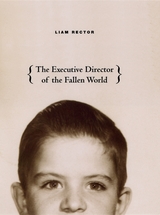 The Executive Director of the Fallen World
Liam Rector
University of Chicago Press, 2006 The Worry of the Far Right The Reverend Donald Wildmon, executive director Of the American Family Association in Tupelo, Mississippi, birthplace of Elvis Presley, he who Unleashed the libido of a generation, announced today That he, the Reverend, wanted again an America In which he could drive his convertible into town, Park it, leave his keys in the ignition, And worry only that it might rain, Rather than worry about Liam Rector. America—you are on notice. Liam Rector has little patience for “sincere” poetry, spin-doctored politicos, or moral hot air of any kind. The titles of these poems could easily serve as their own warning labels: those with clinical depression or easily triggered violent tendencies should use with caution.
The Executive Director of the Fallen World is fearless and forthright, just the sort of blunt reality check that is missing from so much of contemporary, over-stylized poetry. Rector’s stoicism and slightly murderous sense of humor pervade these poems as he doffs his hat to humility and audacity, taking on America, money, movement, marriages, and general cultural mayhem. The characters and voices in Rector’s poems are, by tragic turns, unflinching, clearly and cleanly bitter, sarcastically East Coast, and lyrical. Writing in tercets throughout, the poet breathes new life into this classic form with skill that might just send some unsuspecting readers over the edge.
As the former executive director of the Association of Writers and Writing Programs and a spirited First Amendment advocate who has sparred on screen with Bill O’Reilly, Liam Rector knows whereof he speaks in The Executive Director of the Fallen World.
Executive Leadership in Anglo-American Systems
Colin Campbell
University of Pittsburgh Press, 1991
Eighteen distinguished scholars and practicing officials address the problems of executive leadership in the United States, Britain, Canada, and Australia. Individual essays focus on cabinet government; domestic, military, and economic advisers; executive agencies; and personal staff for presidents and prime ministers. Provocative comparisons between and among systems make the discussions particularly insightful.
 Executive Privilege: A Constitutional Myth
Raoul Berger
Harvard University Press, 1974 In Executive Privilege: A Constitutional Myth, Raoul Berger demonstrates that the presidential claim of authority to withhold information is without historical foundation. This pioneer study is a trenchant refutation of the self-serving presidential “precedents” upon which the executive branch relies. By examining the Parliamentary and constitutional basis for the “claims” of privilege, Berger exposes the shallow and disingenuous “proofs” now on record. His study balances the possible investigatory excesses against the evils which have resulted from resorting to executive secrecy, and Berger maintains that our democratic system is imperiled by the assumption that the people and the Congress may know only as much as the President considers appropriate. If there must be secrecy, Berger concludes, its bounds should be determined by the courts, not by the branch of government interested in concealing unratified policies or misconduct. One of the author's prime examples of how misconstrued power and secrecy have led to disastrous results is the escalation by stealth of America's involvement in the war in Asia. Berger's history is the most complete account of executive privilege ever attempted. His epilogue brings the whole question of executive secrecy up to date.
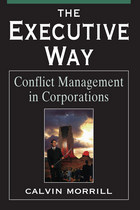 The Executive Way: Conflict Management in Corporations
Calvin Morrill
University of Chicago Press, 1995 What causes conflict among high-level American corporate executives? How do executives manage their conflicts? Based on candid interviews with over two hundred executives and their support personnel, Calvin Morrill provides an intimate portrait of these men and women as they cope with problems usually hidden from those outside their exclusive ranks.
Personal and corporate scandals, compensation battles, budget worries, interdepartmental rivalries, personal enmities, and general rancor are among everyday challenges faced by executives. Morrill shows what most influences the way managers handle routine conflicts are the cultures created by their company's organizational structure: whether there is a strong hierarchy, a weak hierarchy, or an absence of any strong central authority. The issues most likely to cause conflict within corporations Morrill identifies as managerial style, competition between departments, and performance evaluations, promotions, and compensation.
Among the people whose day-to-day lives we get to know are Jacobs, a divisional executive whose intuitive understanding of the corporate hierarchy enables him to topple his incompetent superior without direct confrontation; Fuller, who through a mix of brains, guile, and connections rises from staff executive secretary to corporate vice president in a large bank; Green, an old-fashioned accounting partner in a firm being taken over by management consultants; and the "Princess of Power," "Iron Man," and the "Terminator"—executives fighting their way to the top of a successful entertainment company.
Unprecedented in its direct access to top managers, this portrayal of daily life and conflict management among corporate elites will be of interest to professionals, scholars, and practitioners in organizational culture and behavior, managerial decision making, dispute, social control, law and society, and organizational ethnography.
Exegetic Homilies
Saint Basil
Catholic University of America Press, 1963 No description available
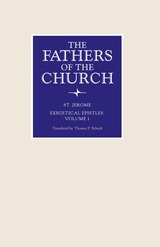 Exegetical Epistles
Jerome
Catholic University of America Press, 2023 The Nicene and Post-Nicene Fathers series of the 19th century rendered into English many of Jerome’s treatises and letters while bypassing his biblical commentaries as well as some of his most important exegetical letters. This omission, which was not helpful to scholarship, was probably due to the great length of these works. Although the problem was partly remedied by some new English translations of the 20th century, the present volume fills a significant lacuna by translating into English the Scriptural exegesis that Jerome conveyed in his relatively unknown epistles, many of which were composed in response to queries he had received from various correspondents. Many of these letters are presented here for the first time in English.
Based on the Hilberg edition, this volume contains new translations, introduced and annotated, of Jerome’s Epistles 18-21, 25-30, 34-37, 42, 53, 55-56, 59, 64-65, 72-74, 78, 85, 106, 112, 119-121, 129, 130, and 140. Two newly translated letters from the famous exchange with Augustine over the meaning of Galatians 2:11-14 are included (Epp. 56 and 112), as well as a new rendering of Ep. 130 to Demetrias (which technically is not an “exegetical” letter but does present important information about the Pelagian controversy). Overall, this collection hopes to serve as a useful introduction to Jerome’s approach to biblical interpretation, of both the Old and the New Testament. Some letters focus on the historical meaning of Pauline and Gospel texts, while others contain allegorical expositions of Old Testament passages. Jerome’s competence as a Hebrew scholar will become evident to the reader of this volume as well as his thorough acquaintance with the antecedent Greek and Latin Christian exegetical traditions.
 Exegetical Epistles, Volume 2
St. Jerome
Catholic University of America Press, 2024 This is the second of a two-volume set that includes Thomas Scheck’s new translations of several of St. Jerome’s previously untranslated exegetical letters. Epistle 85 to St. Paulinus of Nola contains Jerome’s answers to two questions: how Exodus 7.13 and Romans 9.16 can be reconciled with free will, and what 1 Corinthians 7.14 means. Epistle 106 to Sunnias and Fretela, which deals with textual criticism of the Septuagint, consists of a meticulous defense of Jerome’s new translation of the Latin Psalter. Epistle 112 is a response to three letters from St. Augustine: Ep. 56 (contained in the previous volume), Ep. 67, and Ep 104. In the face of Augustine’s criticisms, Jerome defends his own endeavor to translate the Old Testament directly from the
Hebrew text. He also vindicates his own ecclesiastical interpretation of Galatians 2.4-11, as he had set this forth in his Commentary on Galatians, and along the way he accuses Augustine of advocating the heresy of Judaizing. Epistle 119 to Minervius and Alexander contains Jerome’s answers to some eschatological questions regarding the interpretation of 1 Corinthians 15.51 and 1 Thessalonians 4.17. In Epistle 120 to Hedibia, Jerome tackles twelve exegetical questions that focus on reconciling the discrepant Resurrection accounts in the Gospels, as well as questions about Romans 9.14-29, 2 Corinthians 2.16, and 1 Thessalonians 5.23. In Epistle 121 to Algasia, Jerome clarifies eleven exegetical questions dealing with passages in the Gospels and Paul’s letters (Romans 5.7; 7.7-25; 9.3-5; Colossians 2.18-19; 2 Thessalonians 2.3). This letter also contains an exposition of the parable of the unjust steward (Luke 16.1-10), in which Jerome translates material from a commentary attributed to Theophilus of Antioch. In Epistle 129 to
Dardanus, Jerome interprets “the promised land” and discusses the alleged crimes of the Jews. Epistle 130 to Demetrias is not an exegetical letter but an exhortation to the newly consecrated virgin on how to live out her vocation. In this letter Jerome reflects on Origenism and Pelagianism. Finally, in Epistle 140 to Cyprian the presbyter, Jerome expounds Psalm 90.
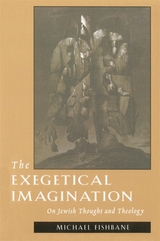 The Exegetical Imagination: On Jewish Thought and Theology
Michael Fishbane
Harvard University Press, 1998 Exegesis--interpretation and explanation of sacred texts--is the quintessence of rabbinic thought. Through such means and methods, the written words of Hebrew Scripture have been extended since antiquity, and given new voices for new times. In this lucid and often poetic book, Michael Fishbane delineates the connections between biblical interpretation and Jewish religious thought.
How can a canon be open to new meanings, given that it is believed to be immutable? Fishbane discusses the nature and rationale of this interpretative process in a series of studies on ancient Jewish speculative theology. Focusing on questions often pondered in Midrash, he shows how religious ideas are generated or justified by exegesis. He also explores the role exegesis plays in liturgy and ritual. A striking example is the transfer of speculative interpretations into meditation in prayer. Cultivation of the ability to perceive many implicit meanings in a text or religious practice can become a way of living--as Fishbane shows in explaining how such notions as joy or spiritual meditations on death can be idealized and the ideal transmitted through theological interpretation. The Exegetical Imagination is a collection of interrelated essays that together offer new and profound understanding of scriptural interpretation and its central role in Judaism.
 An Exemplar of the True: The Tabernacle and the Architecture of Medieval Theology
Allison Zbicz Michael
Catholic University of America Press, 2026 Scholarly academics, cloistered monks, and high-ranking prelates once found abundantly fertile material for theological reflection in the Exodus descriptions of Tabernacle and the Ark of the Covenant. Where traditional scholarly accounts of the rise of scholasticism tend to focus almost entirely on the incorporation of Aristotelian thought and the legacy of Peter Lombard’s sententiae, attention to these works illuminates some of the deeply biblical roots of scholastic patterns of thought. The Tabernacle often appealed to these early interpreters because it provided a valuable source for exploring the structural patterns embedded in creation.
The first part of this book examines the works of four major twelfth-century figures on this popular interpretive theme. Richard of St. Victor, Stephen Langton, Peter of Poitiers, and Adam of Dryburgh each share the conviction that the details of the Tabernacle’s material structure reflect the structures of immaterial truths. The second part of the book shows the rich inheritance of this tradition, as received by Saint Bonaventure and Saint Thomas Aquinas.
In the twelfth-century, the image of the Tabernacle, composed of diverse parts arranged in a coherent whole, provides a divinely-given source for theological method and a model for attempts to systematize and integrate various forms of knowledge. At times, the Tabernacle structure suggests for these interpreters certain correspondences with Aristotelian insights, while elsewhere, the edifice undergirds attempts to offer a rigorous counterbalance to perceived philosophical excesses. In both cases, the Tabernacle is taken as a biblical locus for working through methodological questions prompted by the increasing availability of Aristotle’s corpus. These biblical interpreters bequeathed to the thirteenth-century magistri a structural framework and a confidence that disparate forms of human knowing all fit together.
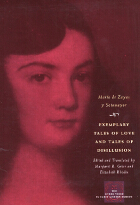 Exemplary Tales of Love and Tales of Disillusion
María de Zayas y Sotomayor
University of Chicago Press, 2009 At the height of María de Zayas’s popularity in the mid-eighteenth century, the number of editions in print of her work was exceeded only by the novels of Cervantes. But by the end of the nineteenth century, Zayas had been excluded from the Spanish literary canon because of her gender and the sociopolitical changes that swept Spain and Europe. Exemplary Tales of Love and Tales of Disillusion gathers a representative sample of seven stories, which features Zayas’s signature topics—gender equality and domestic violence—written in an impassioned tone overlaid with conservative Counter-Reformation ideology. This edition updates the scholarship since the most recent English translations, with a new introduction to Zayas’s entire body of stories, and restores Zayas’s author’s note and prologue, omitted from previous English-language editions. Tracing her slow but steady progress from notions of ideal love to love’s treachery, Exemplary Tales of Love and Tales of Disillusion will restore Zayas to her rightful place in modern letters.
Exemplary Violence: Rewriting History in Colonial Colombia
Alberto Villate-Isaza
Bucknell University Press, 2021 Exemplary Violence explores the violent colonial history of the New Kingdom of Granada (modern-day Colombia and Venezuela) by examining three seventeenth-century historical accounts—Pedro Simón’s Noticias historiales, Juan Rodríguez Freile’s El carnero, and Lucas Fernández de Piedrahita’s Historia general—each of which reveals the colonizer’s reliance on the threat of violence to sustain order.
The Exemplifying Past: A Philosophy of History
Chiel van den Akker
Amsterdam University Press, 2018 This book addresses a wide range of philosophical problems about history and the semantics of time. The point of departure is the distinction between events under the description of past witnesses and their contemporaries and events under the description of historians. Its main claim is that a thesis on the past is exemplified rather than being justified by the available evidence. Such thesis, the book argues, retroactively becomes concrete in the past under consideration. This book will not only appeal to philosophers and historians, but to students and scholars across the humanities.
 Exemptions and Fair Use in Copyright: The Exclusive Rights Tensions in the 1976 Copyright Act
Leon E. Seltzer
Harvard University Press, 1978 After decades of professional dissatisfaction and legislative debate, the Congress in 1976 passed a new copyright act to replace the Copyright Act of 1909. In this book, the author focuses upon the meaning of the "exclusive rights" Constitutional language where writers are concerned, and from his analysis, shows how, when copies of an author's work are made under either the fair-use doctrine or a special exemption for library reproduction of copyrighted works, the 1976 Act has failed to solve old problems and has introduced troublesome new ones. A principal contribution of the book is its analysis of the theoretical foundations of copyright and the establishment of a conceptually coherent framework for the continuing debate on the appropriate limits of copyright protection. Of obvious value to the Copyright Bar and the judiciary, it is also a book that authors, literary agents, and publishers will find they need.
 Exemptions: Necessary, Justified, or Misguided?
Kent Greenawalt
Harvard University Press, 2016 Should laws apply equally to everyone, or should some individuals and organizations be granted exemptions because of conflicting religious or moral convictions? In recent years, this question has become intensely controversial in America. The Supreme Court’s ruling on same-sex marriage, in particular, has provoked barbed debates about legal exemptions. At the core of these debates lies the question of whether basic values of equality and nondiscrimination are at odds with the right to live according to one’s religious beliefs.
In Exemptions: Necessary, Justified, or Misguided? Kent Greenawalt draws on his extensive expertise to place same-sex marriage and other controversies within a broader context. Avoiding oversimplification and reflecting a balanced consideration of competing claims and harms, he offers a useful overview of various types of exemptions and the factors that we should take into account when determining the justice of a particular exemption.
Through a close study of several cases, from doctors who will not perform abortions to institutions that do not pay taxes, Greenawalt demonstrates how to weigh competing values without losing sight of practical considerations like the difficulty of implementing a specific law. This thoughtful guide to exemptions will prove an invaluable resource as America struggles to come to terms with Obergefell v. Hodges, Burwell v. Hobby Lobby, and similar controversies. Exemptions shows how to reach the most just and desirable legal conclusions by respecting those who wish to live according to different fundamental values.
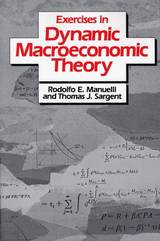 Exercises in Dynamic Macroeconomic Theory
Rodolfo E. Manuelli and Thomas J. Sargent
Harvard University Press, 1987 This book is a companion volume to Dynamic Macroeconomic Theory by Thomas J. Sargent. It provides scrimmages in dynamic macroeconomic theory--precisely the kind of drills that people will need in order to learn the techniques of dynamic programming and its applications to economics. By doing these exercises, the reader can acquire the ability to put the theory to work in a variety of new situations, build technical skill, gain experience in fruitful ways of setting up problems, and learn to distinguish cases in which problems are well posed from cases in which they are not.The basic framework provided by variants of a dynamic general equilibrium model is used to analyze problems in macroeconomics and monetary economics. An equilibrium model provides a mapping from parameters of preferences, technologies, endowments, and "rules of the game" to a probability model for time series. The rigor of the logical connections between theory and observations that the mapping provides is an attractive feature of dynamic equilibrium, or "rational expectations," models. This book gives repeated and varied practice in constructing and interpreting this mapping.
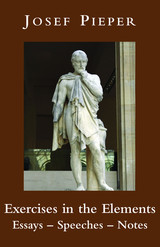 Exercises in the Elements: Essays, Speeches, Notes
Josef Pieper
St. Augustine's Press, 2016 This title, which at first sight seems curious, shows Pieper’s philosophical work as rooted in the basics. He takes his inspiration from Plato – and his Socrates – and Thomas Aquinas. With them, he is interested in philosophy as pure theory, the theoretical being precisely the non-practical. The philosophizer wants to know what all existence is fundamentally about, what “reality” “really” means. With Plato, Pieper eschews the use of language to convince an audience of anything which is not the truth. If Plato was opposed to the sophists – amongst them the politicians –, Pieper is likewise opposed to discourse that leads to the “use” of philosophy to bolster a totalitarian regime or any political or economic system.
A fundamental issue for Pieper is “createdness.” He sees this as the fundamental truth of our being – all being – and the fundamental virtue we can practise is the striving to live according to our perception of real truth in any given situation.
The strength and attraction of Pieper’s writing is its direct and intuitive character which is independent of abstract systematization. He advocates staying in touch with the “real” as we experience it deep within ourselves. Openness to the totality of being – in no matter what context being reveals itself – and the affirmation of all that is founded in this totality are central pillars of all his thinking. Given the “simplicity” of this stance, it is no surprise that much of it is communicated – and successfully – through his gift for illustration by anecdote. Like Plato, this philosopher is a story-teller and, like him, very readable.
 Exeter, 1540-1640: The Growth of an English County Town, Revised Edition
Wallace T. MacCaffrey
Harvard University Press Life in a provincial capital is the subject of this study of Exeter during the Elizabethan and early Stuart ages. The author offers new insight into the way the English middle-class lived and the way in which Tudor policy achieved its aims in the provinces. During this period, Exeter was characterized by its self-sufficiency and by an oligarchical control over every aspect of its civic life. Wallace MacCaffrey describes a semi-autonomous world in itself, in which a small interlocked group of merchant families, related by marriage, kept tight control over the economy, politics, religion, education and social activities.
Taking the inclinations and actions of the local figures as his points of departure, the author discusses such great issues of the age as the Reformation, the war with Spain, and the monarchy, and examines how often they were pushed aside or subordinated to local affairs. Although the local citizen body had no part in national policy making, it was called upon to participate in carrying out the directives which came from London; it did carry out these policies, sometimes successfully, sometimes unsuccessfully.
In writing this detailed study, MacCaffrey has drawn on hitherto unused files from the records of the city.
 Exhausting the Earth: State and Peasant in Hunan, 1500–1850
Peter C. Perdue
Harvard University Press, 1987 Recent agricultural reforms in the People's Republic of China have generated great interest in the ability of the Chinese state, traditional and modern, to accommodate rapid economic change. Exhausting the Earth examines an earlier period—from the late Ming to the mid-Qing era marked by tremendous population growth, extension of the market, and increases in agricultural productivity.
Peter C. Perdue describes the relationship between agricultural production and state policies toward taxation, land clearance, dike-building; property rights, and agriculture in Hunan. During the late seventeenth and early eighteenth centuries, Hunan changed from a peripheral, sparsely populated region into a crowded, highly commercialized, grain-exporting province. State policies had stimulated this growth, but by the early nineteenth century serious signs of overpopulation, social conflict, and ecological exhaustion had surfaced. Local officials were conscious of these dangers, but the influence of the state on the economy was so weakened that they could not alter the ominous trends. The stage was set for the disintegration and rebellion of the nineteenth century. This in-depth study of official policies in one region over a long stretch of time illuminates the dynamics of official initiatives and local response.
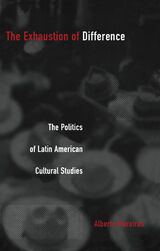 The Exhaustion of Difference: The Politics of Latin American Cultural Studies
Alberto Moreiras
Duke University Press, 2001 The conditions for thinking about Latin America as a regional unit in transnational academic discourse have shifted over the past decades. In The Exhaustion of Difference Alberto Moreiras ponders the ramifications of this shift and draws on deconstruction, Marxian theory, philosophy, political economy, subaltern studies, literary criticism, and postcolonial studies to interrogate the minimal conditions for an effective critique of knowledge given the recent transformations of the contemporary world.
What, asks Moreiras, is the function of critical reason in the present moment? What is regionalistic knowledge in the face of globalization? Can regionalistic knowledge be an effective tool for a critique of contemporary reason? What is the specificity of Latin Americanist reflection and how is it situated to deal with these questions? Through examinations of critical regionalism, restitutional excess, the historical genealogy of Latin American subalternism, testimonio literature, and the cultural politics of magical realism, Moreiras argues that while cultural studies is increasingly institutionalized and in danger of reproducing the dominant ideologies of late capitalism, it is also ripe for giving way to projects of theoretical reformulation. Ultimately, he claims, critical reason must abandon its allegiance to aesthetic-historicist projects and the destructive binaries upon which all cultural theories of modernity have been constructed.
The Exhaustion of Difference makes a significant contribution to the rethinking of Latin American cultural studies.
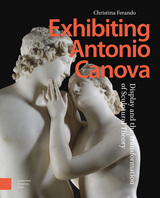 Exhibiting Antonio Canova: Display and the Transformation of Sculptural Theory
Christina Ferando
Amsterdam University Press, 2023 Exhibiting Antonio Canova: Display and the Transformation of Sculptural Theory argues that the display of Canova’s sculptures in the late eighteenth and early nineteenth centuries acted as a catalyst for discourse across a broad range of subjects. By enshrining his marble figures alongside plaster casts of ancient works, bathing them in candlelight, staining and waxing their surfaces, and even setting them in motion on rotating bases, Canova engaged viewers intellectually, physically, and emotionally. These displays inspired discussions on topics as diverse as originality and artistic production, the association between the sculptural surface, flesh, and anatomy, the relationship between painting and sculpture, and the role of public museums. Beholders’ discussions also shaped the legacy of important sculptural theories. They helped usher in their modern definitions and created the lenses through which we experience and interpret works of art, establishing modern attitudes not just towards sculpture, but towards cultural patrimony in general.
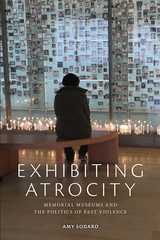 Exhibiting Atrocity: Memorial Museums and the Politics of Past Violence
Sodaro, Amy
Rutgers University Press, 2018 Honorable Mention, 2021 Outstanding First Book Award from the Memory Studies Association Today, nearly any group or nation with violence in its past has constructed or is planning a memorial museum as a mechanism for confronting past trauma, often together with truth commissions, trials, and/or other symbolic or material reparations. Exhibiting Atrocity documents the emergence of the memorial museum as a new cultural form of commemoration, and analyzes its use in efforts to come to terms with past political violence and to promote democracy and human rights. Through a global comparative approach, Amy Sodaro uses in-depth case studies of five exemplary memorial museums that commemorate a range of violent pasts and allow for a chronological and global examination of the trend: the U.S. Holocaust Memorial Museum in Washington, DC; the House of Terror in Budapest, Hungary; the Kigali Genocide Memorial Centre in Rwanda; the Museum of Memory and Human Rights in Santiago, Chile; and the National September 11 Memorial Museum in New York. Together, these case studies illustrate the historical emergence and global spread of the memorial museum and show how this new cultural form of commemoration is intended to be used in contemporary societies around the world. Download open access ebook.
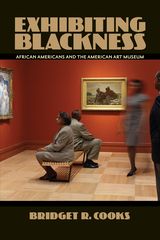 Exhibiting Blackness: African Americans and the American Art Museum
Bridget R. Cooks
University of Massachusetts Press, 2011 In 1927, the Chicago Art Institute presented the first major museum exhibition of art by African Americans. Designed to demonstrate the artists' abilities and to promote racial equality, the exhibition also revealed the art world's anxieties about the participation of African Americans in the exclusive venue of art museums—places where blacks had historically been barred from visiting let alone exhibiting. Since then, America's major art museums have served as crucial locations for African Americans to protest against their exclusion and attest to their contributions in the visual arts.
In Exhibiting Blackness, art historian Bridget R. Cooks analyzes the curatorial strategies, challenges, and critical receptions of the most significant museum exhibitions of African American art. Tracing two dominant methodologies used to exhibit art by African Americans—an ethnographic approach that focuses more on artists than their art, and a recovery narrative aimed at correcting past omissions—Cooks exposes the issues involved in exhibiting cultural difference that continue to challenge art history, historiography, and American museum exhibition practices. By further examining the unequal and often contested relationship between African American artists, curators, and visitors, she provides insight into the complex role of art museums and their accountability to the cultures they represent.
 Exhibiting Chinese Art in Asia: Histories, Politics and Practices
Chui-fun Selina Ho
Amsterdam University Press, 2025 This volume examines the emerging exhibition complex on Chinese art in early twentieth-century China, and from the mid-1950s onwards, the cultural politics involved in Asia with the exhibitions of traditional and modern Chinese art in Taiwan, Japan, Hong Kong and Singapore. It also scrutinizes the curatorial practices that have influenced the interpretation and display of Chinese art amidst the advance of media technology and heritage engagement in the twenty-first century. Situated within ongoing debates on global art history, the volume is inclusive of multiple geo-cultural perspectives, and the dynamic practices that relate art tradition or heritage to more universal spatiotemporal art experience and engagement. It extends the understanding of exhibitions of Chinese art not only as multiple historical processes culturally and politically negotiated and contested by contending forces and diverse actors in the region, but also as creative interventions to engage people around the globe in the present.
Exhibiting Cinema in Contemporary Art
Erika Balsom
Amsterdam University Press, 2013 Whether it involves remaking an old Hollywood movie, projecting a quiet 16mm film, or constructing a bombastic multi-screen environment, cinema now takes place not just in the movie theatre and the home, but also in the art gallery and the museum. The author of this engaging study takes stock of this development, offering an in-depth inquiry into its genesis, its defining features, and the ramifications it has for art and cinema alike. Through the lens of contemporary art history, she examines cinema studies’ great disciplinary obsession – namely, what cinema was, is, and will become in a digital future.
Exhibiting Electricity
K.G. Beauchamp
The Institution of Engineering and Technology, 1997 Throughout the 19th and 20th centuries technical exhibitions, held for the benefit of both cognoscente and the general public alike, have presented a mirror to the progress of science, engineering and, towards the second half of the 19th century and throughout the 20th century, to electrical technology.
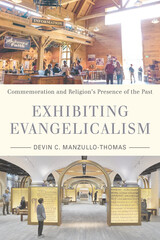 Exhibiting Evangelicalism: Commemoration and Religion’s Presence of the Past
Devin C. Manzullo-Thomas
University of Massachusetts Press, 2022 Religion is a subject often overlooked or ignored by public historians. Whether they are worried about inadvertent proselytizing or fearful of contributing to America’s ongoing culture wars, many heritage professionals steer clear of discussing religion’s formative role in the past when they build collections, mount exhibits, and develop educational programming. Yet religious communities have long been active contributors to the nation’s commemorative landscape. Exhibiting Evangelicalism provides the first account of the growth and development of historical museums created by white evangelical Christians in the United States over the twentieth and twenty-first centuries. Exploring the histories of the Museum of the Bible, the Billy Graham Center Museum, the Billy Sunday Home, and Park Street Church, Devin C. Manzullo-Thomas illustrates how these sites enabled religious leaders to develop a coherent identity for their fractious religious movement and to claim the centrality of evangelicalism to American history. In their zeal to craft a particular vision of the national past, evangelicals engaged with a variety of public history practices and techniques that made them major players in the field—including becoming early adopters of public history’s experiential turn.
Exhibiting Health: Public Health Displays in the Progressive Era
Jennifer Lisa Koslow
Rutgers University Press, 2020 In the early twentieth century, public health reformers approached the task of ameliorating unsanitary conditions and preventing epidemic diseases with optimism. Using exhibits, they believed they could make systemic issues visual to masses of people. Embedded within these visual displays were messages about individual action. In some cases, this meant changing hygienic practices. In other situations, this meant taking up action to inform public policy. Reformers and officials hoped that exhibits would energize America's populace to invest in protecting the public's health. Exhibiting Health is an analysis of the logic of the production and the consumption of this technique for popular public health education between 1900 and 1930. It examines the power and limits of using visual displays to support public health initiatives.
 Exhibiting Jewish Culinary Culture
András Koerner
Central European University Press, 2024 András Koerner is the author of a number of critically acclaimed, award-winning CEU Press titles on the cultural history of Hungarian Jews and Jewish cuisine. This volume continues that tradition by discussing the phenomenon of exhibits on Jewish culinary culture in museums and galleries around the world.
The first part of the book provides an overview of the cultural history of "foodism" and the proliferation of Jewish museums. In addition, it examines the role of cuisine in Jewish identity. It offers an analysis of the history and recent examples of exhibitions on Jewish culinary culture, a subject that has not received scholarly attention until now.
The second part complements this by offering a detailed case study of the book’s subject. It showcases a 2022 exhibition in Budapest on the History of Hungarian Jewish Culinary Culture. András Koerner was the co-curator of the show, thus he is able to offer an insider’s account of its implementation – concept, scope, goals, audience, and design. He also openly discusses the compromises made and mistakes committed in the exhibition’s preparatory work.
This subjective account, quite different from the dry objectivity of catalogues, offers an unusual, behind-the-scenes look at how a complex exhibition like this is prepared. At the same time, the book’s appendix includes images of the display boards and some of the exhibited objects – thus it can also stand for a valuable ex-post catalogue.
Exhibiting Scotland: Objects, Identity, and the National Museum
Alima Bucciantini
University of Massachusetts Press, 2018 In 1707 Scotland ceased to exist as an independent country and became part of Great Britain. Yet it never lost its distinct sense of identity, history, and politics. To preserve the country's unique antiquities and natural specimens, a Scottish earl founded the Society of Antiquaries of Scotland in 1780, at the beginning of the Enlightenment's museum boom. Now numbering twelve million objects and specimens and representing everything from archaeology to applied arts and design, from social history to science and the natural world, these collections formed the foundation for what eventually became the National Museum of Scotland.
In Exhibiting Scotland, Alima Bucciantini traces how these collections have helped tell the changing stories of this country for centuries and how the museum reflects the Scots' continuing negotiation of their place within modern Britain.
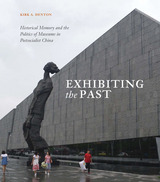 Exhibiting the Past: Historical Memory and the Politics of Museums in Postsocialist China
Kirk A. Denton
University of Hawaii Press, 2014 During the Mao era, China’s museums served an explicit and uniform propaganda function, underlining official Party history, eulogizing revolutionary heroes, and contributing to nation building and socialist construction. With the implementation of the post-Mao modernization program in the late 1970s and 1980s and the advent of globalization and market reforms in the 1990s, China underwent a radical social and economic transformation that has led to a vastly more heterogeneous culture and polity. Yet China is dominated by a single Leninist party that continues to rely heavily on its revolutionary heritage to generate political legitimacy. With its messages of collectivism, self-sacrifice, and class struggle, that heritage is increasingly at odds with Chinese society and with the state’s own neoliberal ideology of rapid-paced development, glorification of the market, and entrepreneurship. In this ambiguous political environment, museums and their curators must negotiate between revolutionary ideology and new kinds of historical narratives that reflect and highlight a neoliberal present.
In Exhibiting the Past, Kirk Denton analyzes types of museums and exhibitionary spaces, from revolutionary history museums, military museums, and memorials to martyrs to museums dedicated to literature, ethnic minorities, and local history. He discusses red tourism—a state sponsored program developed in 2003 as a new form of patriotic education designed to make revolutionary history come alive—and urban planning exhibition halls, which project utopian visions of China’s future that are rooted in new conceptions of the past. Denton’s method is narratological in the sense that he analyzes the stories museums tell about the past and the political and ideological implications of those stories. Focusing on “official” exhibitionary culture rather than alternative or counter memory, Denton reinserts the state back into the discussion of postsocialist culture because of its centrality to that culture and to show that state discourse in China is neither monolithic nor unchanging. The book considers the variety of ways state museums are responding to the dramatic social, technological, and cultural changes China has experienced over the past three decades.
 Exhibits in Archives and Special Collections Libraries
Jessica Lacher-Feldman
Society of American Archivists, 2013 In EXHIBITS IN ARCHIVES AND SPECIAL COLLECTIONS LIBRARIES, longtime special collections exhibits curator Jessica Lacher-Feldman advises archivists at all levels on developing enlightening and entertaining exhibits. She describes each step of the exhibit process, providing straightforward tips on:
Developing innovative exhibit ideas
Formulating exhibit policies and procedures for your institution
Crafting well-written and visually interesting exhibit labels
Branding and designing exhibits
Promoting exhibits through conventional media, social media, and give-away items
Also included are case studies that detail exhibits at a variety of institutions, sample documents and forms, a literature review, and a guide to exhibit supplies.
Exhibit development doesn't have to be complicated or overwhelming. With this comprehensive resource, you'll learn how to develop exhibits that help you to better connect with your audience and advocate for your repository. "Proceed and be bold" with exhibit development, and gratifying, inspiring results will transpire.
Exhortations to Women and to Others If They Please
Lucrezia Marinella
Iter Press, 2012 With this translation of Marinella’s Exhortations to Women and to Others if They Please we can now read another crucial text from her extensive body of work, one that signals a radical ideological shift from her best known text, The Nobility and Excellence of Women; we can thus enjoy a fuller picture of the author and her opinions. Only three copies of Exhortations have been located in any library, and in the absence of a critical edition this translation will prove to be a point of reference for scholars and students alike. Benedetti’s thorough introduction situates Marinella and her works within early seventeenth-century Venetian culture and the Counter-Reformation more broadly, in a way that is profoundly influenced by philology and is also theoretically sound.
—Maria Galli Stampino
Associate Professor of French and Italian
University of Miami
Exhuming Franco: Spain's Second Transition, Second Edition
Sebastiaan Faber
Vanderbilt University Press, 2023 Through dozens of interviews, intensive reporting, and deep research and analysis, Sebastiaan Faber sets out to understand what remains of Francisco Franco's legacy in Spain today. Faber's work is grounded in heavy scholarship, but the book is an engaging, accessible introduction to a national conversation about fascism. Spurred by the disinterment of the dictator in 2019, Faber finds that Spain is still deeply affected—and divided—by the dictatorial legacies of Francoism.
This new edition, with additional interviews and a new introduction, illuminates the dangers of the rise of right-wing nationalist revisionism by using Spain as a case study for how nations face, or don't face, difficult questions about their past.
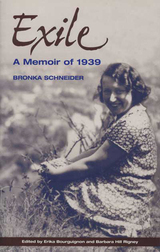 EXILE: A MEMOIR OF 1939
Bronka Schneider Edited with forewords by Erika Bourguignon and Barbara Hill Rigney
Ohio State University Press, 1998 Bronka Schneider and her husband, Joseph, were two of the thirty thousand Austrian Jews admitted as refugees to Great Britain between March 1938 and 2 September 1939. It was not until 1960, however, that Schneider wrote her memoir about the year she spent as a housekeeper, with Joseph as a butler, in a Scottish castle. Schneider tells of daily encounters—with her employers, the English lady and her husband, a retired British civil servant who had spent many years in India; the village locals; other refugees; and a family of evacuees from the slums of Glasgow.
The editors have divided this memoir into chapters, adding headlines from the London Times as epigraphs. These headlines, reporting the escalating events of World War II, are in stark contrast to daily activities of the residents of this isolated region of Scotland. A commentary by Erika Bourguignon provides historical, political, and cultural background of this period.
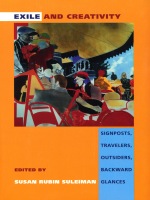 Exile and Creativity: Signposts, Travelers, Outsiders, Backward Glances
Susan Rubin Suleiman, ed.
Duke University Press, 1998 A major historical phenomenon of our century, exile has been a focal point for reflections about individual and cultural identity and problems of nationalism, racism, and war. Whether emigrés, exiles, expatriates, refugees, or nomads, these people all experience a distance from their homes and often their native languages. Exile and Creativity brings together the widely varied perspectives of nineteen distinguished European and American scholars and cultural critics to ask: Is exile a falling away from a source of creativity associated with the wholeness of home and one’s own language, or is it a spur to creativity? In essays that range chronologically from the Renaissance to the 1990s, geographically from the Danube to the Andes, and historically from the Inquisition to the Holocaust, the complexities and tensions of exile and the diversity of its experiences are examined. Recognizing exile as an interior experience as much as a physical displacement, this collection discusses such varied topics as intellectual exile and seventeenth-century French literature; different versions of home and of the novel in the writings of Bakhtin and Lukács; the displacement of James Joyce and Clarice Lispector; a young journalist’s meeting with James Baldwin in the south of France; Jean Renoir’s Hollywood years; and reflections by the descendents of European emigrés. Strikingly, many of the essays are themselves the work of exiles, bearing out once more the power of the personal voice in scholarship. With the exception of the contribution by Henry Louis Gates Jr., these essays were originally published in a special double issue of Poetics Today in 1996. Exile and Creativity will engage a range of readers from those whose specific interests include the problems of displacement and diaspora and the European Holocaust to those whose broad interests include art, literary and cultural studies, history, film, and the nature of human creativity. Contributors. Zygmunt Bauman, Janet Bergstrom, Christine Brooke-Rose, Hélène Cixous, Tibor Dessewffy, Marianne Hirsch, Denis Hollier, Henry Louis Gates Jr., Linda Nochlin, Leo Spitzer, Susan Rubin Suleiman, Thomas Pavel, Doris Sommer, Nancy Huston, John Neubauer, Ernst van Alphen, Alicia Borinsky, Svetlana Boym, Jacqueline Chénieux-Gendron
 Exile and Cultural Hegemony: Spanish Intellectuals in Mexico, 1939-1975
Sebastiaan Faber
Vanderbilt University Press, 2002 After Francisco Franco's victory in the Spanish Civil War, a great many of the country's intellectuals went into exile in Mexico. During the three and a half decades of Francoist dictatorship, these exiles held that the Republic, not Francoism, represented the authentic culture of Spain. In this environment, as Sebastiaan Faber argues in Exile and Cultural Hegemony, the Spaniards' conception of their role as intellectuals changed markedly over time.
The first study of its kind to place the exiles' ideological evolution in a broad historical context, Exile and Cultural Hegemony takes into account developments in both Spanish and Mexican politics from the early 1930s through the 1970s. Faber pays particular attention to the intellectuals' persistent nationalism and misplaced illusions of pan-Hispanist grandeur, which included awkward and ironic overlaps with the rhetoric employed by their enemies on the Francoist right. This embrace of nationalism, together with the intellectuals' dependence on the increasingly authoritarian Mexican regime and the international climate of the Cold War, eventually caused them to abandon the Gramscian ideal of the intellectual as political activist in favor of a more liberal, apolitical stance preferred by, among others, the Spanish philosopher Jose Ortega y Gasset.
With its comprehensive approach to topics integral to Spanish culture, both students of and those with a general interest in twentieth-century Spanish literature, history, or culture will find Exile and Cultural Hegemony a fascinating and groundbreaking work.
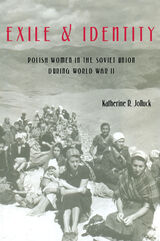 Exile and Identity: Polish Women in the Soviet Union during World War II
Katherine R. Jolluck
University of Pittsburgh Press, 2002 Using firsthand, personal accounts, and focusing on the experiences of women, Katherine R. Jolluck relates and examines the experiences of thousands of civilians deported to the USSR following the Soviet annexation of eastern Poland in 1939.
Upon arrival in remote areas of the Soviet Union, they were deposited in prisons, labor camps, special settlements, and collective farms, and subjected to tremendous hardships and oppressive conditions. In 1942, some 115,000 Polish citizens—only a portion of those initially exiled from their homeland—were evacuated to Iran. There they were asked to complete extensive questionnaires about their experiences.
Having read and reviewed hundreds of these documents, Jolluck reveals not only the harsh treatment these women experienced, but also how they maintained their identities as respectable women and patriotic Poles. She finds that for those exiled, the ways in which they strove to recreate home in a foreign and hostile environment became a key means of their survival.
Both a harrowing account of brutality and suffering and a clear analysis of civilian experiences in wartime, Exile and Identity expands the history of war far beyond the military battlefield.
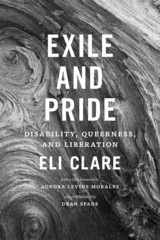 Exile and Pride: Disability, Queerness, and Liberation
Eli Clare
Duke University Press, 2015 First published in 1999, the groundbreaking Exile and Pride is essential to the history and future of disability politics. Eli Clare's revelatory writing about his experiences as a white disabled genderqueer activist/writer established him as one of the leading writers on the intersections of queerness and disability and permanently changed the landscape of disability politics and queer liberation. With a poet's devotion to truth and an activist's demand for justice, Clare deftly unspools the multiple histories from which our ever-evolving sense of self unfolds. His essays weave together memoir, history, and political thinking to explore meanings and experiences of home: home as place, community, bodies, identity, and activism. Here readers will find an intersectional framework for understanding how we actually live with the daily hydraulics of oppression, power, and resistance. At the root of Clare's exploration of environmental destruction and capitalism, sexuality and institutional violence, gender and the body politic, is a call for social justice movements that are truly accessible to everyone. With heart and hammer, Exile and Pride pries open a window onto a world where our whole selves, in all their complexity, can be realized, loved, and embraced.
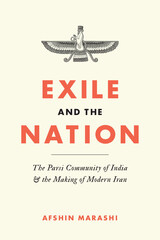 Exile and the Nation: The Parsi Community of India and the Making of Modern Iran
By Afshin Marashi
University of Texas Press, 2020 Honorable Mention, Hamid Naficy Iranian Studies Book Award from the Association of Iranian Studies In the aftermath of the seventh-century Islamic conquest of Iran, Zoroastrians departed for India. Known as the Parsis, they slowly lost contact with their ancestral land until the nineteenth century, when steam-powered sea travel, the increased circulation of Zoroastrian-themed books, and the philanthropic efforts of Parsi benefactors sparked a new era of interaction between the two groups. Tracing the cultural and intellectual exchange between Iranian nationalists and the Parsi community during the late nineteenth and early twentieth centuries, Exile and the Nation shows how this interchange led to the collective reimagining of Parsi and Iranian national identity—and the influence of antiquity on modern Iranian nationalism, which previously rested solely on European forms of thought. Iranian nationalism, Afshin Marashi argues, was also the byproduct of the complex history resulting from the demise of the early modern Persianate cultural system, as well as one of the many cultural heterodoxies produced within the Indian Ocean world. Crossing the boundaries of numerous fields of study, this book reframes Iranian nationalism within the context of the connected, transnational, and global history of the modern era.
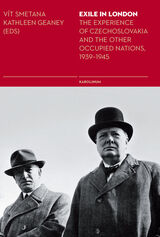 Exile in London: The Experience of Czechoslovakia and the Other Occupied Nations, 1939–1945
Edited by Vít Smetana and Kathleen Brenda Geaney
Karolinum Press, 2018 During World War II, London experienced not just the Blitz and the arrival of continental refugees, but also an influx of displaced foreign governments. Drawing together renowned historians from nine countries—the United Kingdom, Germany, the Netherlands, Belgium, Poland, the former Yugoslavia, the Czech Republic, and Slovakia—this book explores life in exile as experienced by the governments of Czechoslovakia and other occupied nations who found refuge in the British capital. Through new archival research and fresh historical interpretations, chapters delve into common characteristics and differences in the origin and structure of the individual governments-in-exile in an attempt to explain how they dealt with pressing social and economic problems at home while abroad; how they were able to influence crucial Allied diplomatic negotiations; the relative importance of armies, strategic commodities, and equipment that particular governments-in-exile were able to offer to the allied war effort; important wartime propaganda; and early preparations for addressing postwar minority issues.
 The Exile Mission: The Polish Political Diaspora and Polish Americans, 1939–1956
Anna D. Jaroszynska-Kirchmann
Ohio University Press, 2009 At midcentury, two distinct Polish immigrant groups—those Polish Americans who were descendants of economic immigrants from the turn of the twentieth century and the Polish political refugees who chose exile after World War II and the communist takeover in Poland—faced an uneasy challenge to reconcile their concepts of responsibility toward the homeland. The new arrivals did not consider themselves simply as immigrants, but rather as members of the special category of political refugees. They defined their identity within the framework of the exile mission, an unwritten set of beliefs, goals, and responsibilities, placing patriotic work for Poland at the center of Polish immigrant duties. In The Exile Mission, an intriguing look at the interplay between the established Polish community and the refugee community, Anna Jaroszyńska–Kirchmann presents a tale of Polish Americans and Polish refugees who, like postwar Polish exile communities all over the world, worked out their own ways to implement the mission’s main goals. Between the outbreak of World War II and 1956, as Professor Jaroszyńska–Kirchmann demonstrates, the exile mission in its most intense form remained at the core of relationships between these two groups. The Exile Mission is a compelling analysis of the vigorous debate about ethnic identity and immigrant responsibility toward the homeland. It is the first full–length examination of the construction and impact of the exile mission on the interactions between political refugees and established ethnic communities.
Exile, Nature, and Transformation in the Life of Mary Hallock Foote
Megan Riley McGilchrist
University of Nevada Press, 2021 This book is about exile and transformation. It is primarily about Mary Hallock Foote, nineteenth-century artist and writer, easterner-turned-westerner, but it is a hybrid work - as well as being about Mary, it is about what it has been like for me, a twenty-first century American expatriate, Californian-turned-Londoner, to find common ground in the life of a nineteenth century woman.
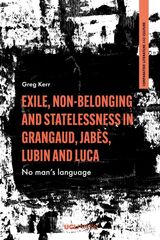 Exile, Non-Belonging and Statelessness in Grangaud, Jabès, Lubin and Luca: No Man's Language
Greg Kerr
University College London, 2021 A close study of four French-language poets and the poetry of exile.
Poetry has often been understood as a powerful vector of collective belonging. The idea that certain poets are emblematic of a national culture is one of the chief means by which literature historicizes itself, inscribes itself in a shared cultural past, and supplies modes of belonging to those who consume it. But, how does the exiled, migrant, or translingual poet complicate this narrative? For Armen Lubin, Ghérasim Luca, Edmond Jabès, and Michelle Grangaud, the practice of poetry is inseparable from a sense of restlessness or unease. Ranging across borders within and beyond the Francosphere—from Algeria, Armenia, Egypt, and Romania—this book shows how a poetic practice inflected by exile, statelessness, or non-belonging has the potential to disrupt long-held assumptions about the relation between subjects, the language they use, and the place from which they speak.
 The Exile of Britney Spears: A Tale of 21st-Century Consumption
Christopher R. Smit
Intellect Books, 2011 As sustainability and eco-responsibility become a part of our everyday cultural conversation, we’re finally being forced to acknowledge that what we consume matters. What we fail to realize is that we unconsciously, continually, and at times violently consume much more than just food—including celebrities. The Exile of Britney Spears takes the ubiquitous pop star of its title as its primary example, explaining that we have consumed, digested, and eliminated Britney Spears in a process uniquely characteristic of American popular culture. In Christopher Smit’s provocative account of the sociological, aesthetic, and political outcomes of this new mediated cannibalism, he offers the idea of exile as a new metaphor for the outcome of popular consumption. By investigating the psychological, personal, and social matrix of Britney’s rise and fall, he outlines the process of her inevitable exile from global taste and favor.
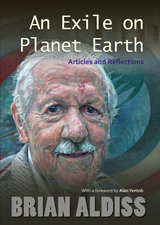 An Exile on Planet Earth: Articles and Reflections
Brian Aldiss
Bodleian Library Publishing, 2012 Brian Aldiss is one of the great figures in science fiction. Classics in the genre, his books serve as portals to other worlds, captivating readers with strange and shocking narratives that have been a force for further experimentation within the genre. In addition to a highly successful career as a writer of both fiction and science fiction, Aldiss is also an accomplished artist and literary critic. An Exile on Planet Earth presents a selection of Aldiss’s essays that look back at the landmark events in his life. Writing with eloquence and raw honesty, Aldiss reveals unexpected connections between his life and literary work. From boarding school and boyhood summers spent alone at the shore comes the lonely boy playing on the beach in Walcot. The bitter break-up of Aldiss’s first marriage is revealed to be the inspiration behind the post-apocalyptic Greybeard, in which a nuclear accident results in a world without children. Exile is a recurring theme throughout Aldiss’s work, and the essays shed light on the ways in which he identified with this theme and constructed elaborate metaphors informed by it. Also included is Aldiss’s introduction to H. G. Wells’s War of the Worlds and an imagined conversation with English novelist Thomas Hardy. For the many fans of Aldiss’s weird and wonderful work, An Exile on Planet Earth offers a look at the man behind the books and short stories, including new insights into the events that fueled his creative talent, as well as reflections on his place in the genre and the cultural significance of science fiction as a whole.
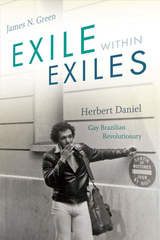 Exile within Exiles: Herbert Daniel, Gay Brazilian Revolutionary
James N. Green
Duke University Press, 2018 Herbert Daniel was a significant and complex figure in Brazilian leftist revolutionary politics and social activism from the mid-1960s until his death in 1992. As a medical student, he joined a revolutionary guerrilla organization but was forced to conceal his sexual identity from his comrades, a situation Daniel described as internal exile. After a government crackdown, he spent much of the 1970s in Europe, where his political self-education continued. He returned to Brazil in 1981, becoming engaged in electoral politics and social activism to champion gay rights, feminism, and environmental justice, achieving global recognition for fighting discrimination against those with HIV/AIDS. In Exile within Exiles, James N. Green paints a full and dynamic portrait of Daniel's deep commitment to leftist politics, using Daniel's personal and political experiences to investigate the opposition to Brazil's military dictatorship, the left's construction of a revolutionary masculinity, and the challenge that the transition to democracy posed to radical movements. Green positions Daniel as a vital bridge linking former revolutionaries to the new social movements, engendering productive dialogue between divergent perspectives in his writings and activism.
 Exile Within: The Schooling of Japanese Americans, 1942–1945
Thomas James
Harvard University Press, 1987 During World War II, 110,000 Japanese Americans--30,000 of them children--were torn from their homes and incarcerated in camps surrounded by barbed wire and military guards in what the ACLU has called "the greatest deprivation of civil rights by government in this country since slavery." The experience of these children left a tangle of social meanings that had not been inspected with the care it deserves until this book was written. Because they were schoolchildren, theirs was an educational history; and Thomas James tells it here, fully mindful of the irony of children studying democracy and its ideals while suffering as victims of the most undemocratic of all processes--imprisonment in a relocation camp solely on the basis of their race.James uses the rich documentary evidence in the records of the War Relocation Authority and other archives to survey the camps as educational institutions. Photographs of life in the camps show uncomprehending, innocent faces tinged with sadness. What sort of education took place? What did educators think they were doing there? How did the children react and adjust?James interprets the improbable hope of educational planners that they could make good on America's promise to provide educational opportunity for its citizens even under adverse conditions. What began as a story of war hysteria and racial exclusion in 1942 soon became a more complicated history of public institutions that embodied conflicting motives and numerous layers of authority and expertise. Incongruous elements of coercion and idealism led to conflict in the camps, and differences of opinion deepened when the government required declarations of loyalty while denying civil liberty. For the children, education continued despite inadequate resources, a high teacher turnover rate, and frequent confusion about ends and means. The role of the older generation in preserving cultural expression and in insisting on continuity of education was a crucial thread in the social history of the camps.Exile Within makes a strong contribution to the history of minority groups and of education in the United States; to the literature on children in crisis; and to our understanding of the contradictory uses of public authority under a democratic form of government.
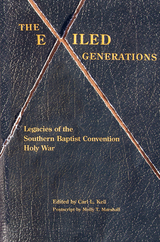 The Exiled Generations: Legacies of the Southern Baptist Convention Holy Wars
Carl L. Kell
University of Tennessee Press, 2015 The Exiled Generations is a collection of poignant testimonials by individuals whose parents and relatives were purged from or left the Southern Baptist Convention in the wake of the fundamentalist takeover beginning in 1980. Building upon Professor Kell’s earlier work, Exiled, which revealed the stories of those who were themselves expurgated, this new book details the experiences of their relations—the sons and daughters who saw their moderate-leaning parents lose pastoral positions, administrative posts, missionary appointments, or seminary professorships, and who faced their own often fraught relationships with their church home.
Until now, the stories of this “lost generation” have never been fully told. In this collection, Professor Kell presents a diverse and wide range of voices. Some are well-known Baptist leaders, while others are ordinary people caught up in the remarkable changes in Baptist life over the past few decades. Here, they recount their feelings of loss as they were severed from youth fellowships and removed from church rolls. Many describe the lingering emotional effects of the heartbreaking conflict that dominated their childhood and adolescence. Their recollections reveal the full range of responses—anger, sadness, pathos, humor, intense inner reflection—to these enormous shifts. This volume shows the extent to which this group has struggled and wandered in emotional and religious exile.
The Exiled Generations comprises rich primary sources for scholars and students who are exploring the profound strife that has rocked the Southern Baptist Convention. These deeply moving accounts will offer invaluable assistance to researchers analyzing the impact of the seismic changes within the denomination over the past thirty-five years.
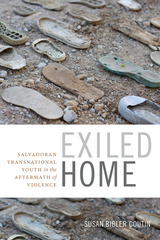 Exiled Home: Salvadoran Transnational Youth in the Aftermath of Violence
Susan Bibler Coutin
Duke University Press, 2016 In Exiled Home, Susan Bibler Coutin recounts the experiences of Salvadoran children who migrated with their families to the United States during the 1980–1992 civil war. Because of their youth and the violence they left behind, as well as their uncertain legal status in the United States, many grew up with distant memories of El Salvador and a profound sense of disjuncture in their adopted homeland. Through interviews in both countries, Coutin examines how they sought to understand and overcome the trauma of war and displacement through such strategies as recording community histories, advocating for undocumented immigrants, forging new relationships with the Salvadoran state, and, for those deported from the United States, reconstructing their lives in El Salvador. In focusing on the case of Salvadoran youth, Coutin’s nuanced analysis shows how the violence associated with migration can be countered through practices that recuperate historical memory while also reclaiming national membership.
 Exiled in L.A.: The Untold Story of Leopold Fischer’s Domestic Architecture
Volker M. Welter
J. Paul Getty Trust, The The first English-language volume to explore the work of architect Leopold Fischer, and the inaugural study of his California legacy.
In 1936, Leopold Fischer (1901–1975), in exile from Nazi Germany, arrived in California, where he created a small but distinct oeuvre of mostly domestic architecture. In contrast to his famous peers Rudolph Schindler and Richard Neutra, immigrants whose Southern California buildings are frequently examined—and who, like Fischer, studied with the modernist architect Adolf Loos—Fischer and his California structures have, until now, escaped the attention of architectural history.
Exiled in L.A. examines Fischer’s important, yet overlooked, contributions to Southern California architecture. As the whereabouts of Fischer’s archives remain unknown, Volker M. Welter grounds the designer’s California works in comparison with his pre-exile projects and the compositions of fellow architects in California. In the 1920s, Fischer created experimental working-class housing estates in Germany that pioneered ecological construction and living practices. Comparable to their predecessors, Fischer's California buildings revolve around the “functioning, the organization of a home,” as he defined domestic architecture in 1926. Featuring new photography and detailed architectural plans, this book is an original contribution to the literature on Southern California’s built heritage.
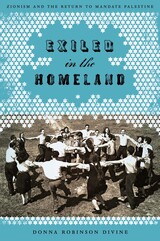 Exiled in the Homeland: Zionism and the Return to Mandate Palestine
By Donna Robinson Divine
University of Texas Press, 2009 Offering a new perspective on Zionism, Exiled in the Homeland draws on memoirs, newspaper accounts, and archival material to examine closely the lives of the men and women who immigrated to Palestine in the early twentieth century. Rather than reducing these historic settlements to a single, unified theme, Donna Robinson Divine's research reveals an extraordinary spectrum of motivations and experiences among these populations. Though British rule and the yearning for a Jewish national home contributed to a foundation of solidarity, Exiled in the Homeland presents the many ways in which the message of emigration settled into the consciousness of the settlers. Considering the benefits and costs of their Zionist commitments, Divine explores a variety of motivations and outcomes, ranging from those newly arrived immigrants who harnessed their ambition for the goal of radical transformation to those who simply dreamed of living a better life. Also capturing the day-to-day experiences in families that faced scarce resources, as well as the British policies that shaped a variety of personal decisions on the part of the newcomers, Exiled in the Homeland provides new keys to understanding this pivotal chapter in Jewish history.
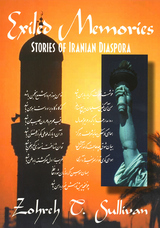 Exiled Memories: Stories of Iranian Diaspora
Zohreh T. Sullivan
Temple University Press, 2001 "I feel I am the wandering Jew who has no place to which she belongs. I thought I could settle down, but can't imagine staying. Whenever I bought a bar of soap and two came in the package, I thought there would be no need to buy a package of two because I would never last through the second. Why? Because I knew I was returning to Iran -- tomorrow. So too, I would buy the smallest size of toothpastes and jars of oil. Putting down roots here is an impossibility."
These are the words of one Iranian emigre, driven from Tehran by the revolution of 1979. They are echoed time and again in this powerful portrayal of loss and survival. Impelled by these word and her own concerns about nationality and identity, Zohreh Sullivan has gathered together here the voices of sixty exiles and emigres. The speakers come from various ethnic and religious backgrounds and range in age from thirteen to eighty-eight. Although most are from the middle class, they work in a variety of occupations in the United States. But whatever their differences, here they engage in remembering the past, producing a discourse about their lives, and negotiating the troubled transitions from one culture to another.
Unlike man other Iranian oral history projects, Exiled Memories looks at the reconstruction of memory and identity through diasporic narratives, through a focus on the Americas rather than on Iran. The narratives included here reveal the complex ways in which events and places transform identities, how overnight radical s become conservatives, friends become enemies, the strong become weak. Indeed, the narratives themselves serve this function -- serving to transfer or transform power and establish credibility. They reveal a diverse group of people in the process of knitting the story of themselves with the story of the collective after it has been torn apart.
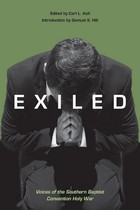 Exiled: Voices of the Southern Baptist Convention Holy War
Carl Kell
University of Tennessee Press, 2006 "These personal narratives of distinguished Baptists illustrate the adverse consequences of exclusive fundamentalism, and the need for unity among traditional Baptists." —Jimmy Carter
It has been one of the major news stories in religion and culture of the past twenty-five years. From 1979 to 1995, the Southern Baptist Convention (SBC) was rocked by assaults on its leadership by fundamentalists, who used questionable tactics to gain top positions and then used their power to purge Baptist seminary presidents and professors, church pastors, lay leaders, and women from positions of responsibility. America's largest Christian, non-Catholic denomination is firmly locked in a “holy war” to secure its churches and membership for a never-ending struggle against a liberal culture.
Exiled: Voices of the Southern Baptist Convention Holy War is a compilation of first-person narratives by conservative and moderate ministers and lay leaders who were stripped of their positions and essentially became pariahs in the churches to which they had devoted their lives.
While other books have described the takeover in historical, political, and theological terms, Exiled is different. Individual people tell their personal stories, revealing the struggle and heartache that resulted from being vilified, dispossessed, and exiled. Kell includes a variety of perspectives-from lay preachers and church members to prominent former SBC leaders such as James Dunn and Carolyn Crumpler.
The emotion captured on the pages-sadness, shock, disbelief, resignation, and anger-will make Exiled moving even to readers who know little about the Southern Baptist movement. Exiled will also be of particular interest to historians, sociologists, philosophers of religion, and rhetorical historians.
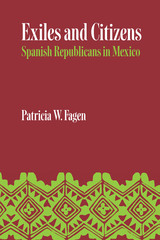 Exiles and Citizens: Spanish Republicans in Mexico
By Patrcia W. Fagen
University of Texas Press, 1973 At the end of the Spanish civil war, Mexico was the only country to offer open refuge to the thousands of Republican emigrés who fled from Spain in 1939–1940. Exiles and Citizens is a study of these political exiles, especially those with intellectual and professional backgrounds and ambitions. It focuses on their adjustment to Mexico, on their continued ties to Spain, and on their impact on Mexican development. The critical dilemma faced by the Spanish exiles was that, despite having fought for their political and social ideals in Spain, they forfeited in exile their active role in Spanish history. In Mexico they found a political and social system that seemed to include many of the ideals that had inspired the Spanish Republic; moreover, they were able to incorporate themselves economically, professionally, and intellectually into Mexican national life. Yet, because they were not native-born citizens, they had little or no creative part to play in the politics of their adopted country. For Mexico, the impact of the refugees from Spain was enormous. Integrated from the first into nearly all intellectual, professional, and cultural fields, their skills proved an important catalyst to Mexican development. Yet, outside these fields, Mexico was never an effective "melting pot." The Republicans themselves were divided in their loyalties, and the Mexicans, from the beginning, were reluctant to encourage the full participation of their guests in national affairs. Two goals were shared by most of the exiles: to ensure that the world would remember the liberal, creative, and open Spain they had created and thus reject Franco; to show their gratitude by working for the benefit and progress of Mexico. These goals, although frequently contradictory, sustained the emigration and gave meaning to exile. The refugees tried to maintain their identity by coming together in formal and informal associations that were intended either to act on behalf of the homeland or to re-create the Spanish Republican structures and values in exile. To maintain a Spanish identity, however, proved difficult, and for the second and third generations in Mexico, the initial goals had already lost their meaning. For them, economic and professional, as well as familial, ties were strongly Mexican. Spanish Republicans in Mexico represented a fairly rare phenomenon: a large group of skilled, relatively well educated immigrants to a country where persons of their attainments and status were not numerous. Moreover, as political exiles, they approached the problems of acculturation differently from economic emigrants. Patricia Fagen's study thus offers a further understanding of an important exile community and the characteristics that set it apart from other examples of immigrant experiences. In addition, the study sheds new light on the intellectual history of Mexico and the far-reaching effects of the Spanish civil war.
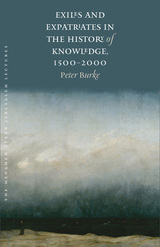 Exiles and Expatriates in the History of Knowledge, 1500–2000
Peter Burke
Brandeis University Press, 2017 In this wide-ranging consideration of intellectual diasporas, historian Peter Burke questions what distinctive contribution to knowledge exiles and expatriates have made. The answer may be summed up in one word: deprovincialization. Historically, the encounter between scholars from different cultures was an education for both parties, exposing them to research opportunities and alternative ways of thinking. Deprovincialization was in part the result of mediation, as many émigrés informed people in their “hostland” about the culture of the native land, and vice versa. The detachment of the exiles, who sometimes viewed both homeland and hostland through foreign eyes, allowed them to notice what scholars in both countries had missed. Yet at the same time, the engagement between two styles of thought, one associated with the exiles and the other with their hosts, sometimes resulted in creative hybridization, for example, between German theory and Anglo-American empiricism. This timely appraisal is brimming with anecdotes and fascinating findings about the intellectual assets that exiles and immigrants bring to their new country, even in the shadow of personal loss.
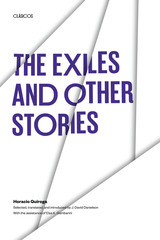 The Exiles and Other Stories
By Horacio Quiroga
University of Texas Press, 1987 Tales of risk and danger, suffering, disease, horror, and death. Tales, also, of courage and dignity, hard work, and human endurance in the face of hostile nature and the frequent brutality of men. And tales flavored with piquant touches of humor and bemused irony. These are the stories of the Uruguayan writer Horacio Quiroga, here presented in an important compilation of thirteen of his most compelling tales, sensitively selected and translated by J. David Danielson. Author of some two hundred pieces of fiction, often compared to the works of Kipling, Jack London, and Edgar Allan Poe, Quiroga set many of his stories in the territory of Misiones in northeastern Argentina, the subtropical jungle region where he spent much of his life. Included here are stories from Los desterrados (1926) often said to be his best book, as well as others from Cuentos de amor de locura y de muerte (1917), Anaconda (1921), and El Desierto (1924). The publication of this selection marks the first appearance in English of all but two of the thirteen stories. Quiroga here presents a wide range of characters: parents and children, servant girls and prostitutes, landowners and lumber barons, foremen and laborers, natives and immigrants, in stories pervaded by a vision of life that is elemental, incisive, and essentially tragic. The Exiles and Other Stories shows the versatility and skill that have made him a classic Spanish American writer. It complements and illumines The Decapitated Chicken and Other Stories, selected and translated by Margaret Sayers Peden, also published by the University of Texas Press.
 Exiles at Home: The Struggle to Become American in Creole New Orleans
Shirley Elizabeth Thompson
Harvard University Press, 2009 New Orleans has always captured our imagination as an exotic city in its racial ambiguity and pursuit of les bons temps. Despite its image as a place apart, the city played a key role in nineteenth-century America as a site for immigration and pluralism, the quest for equality, and the centrality of self-making.
In both the literary imagination and the law, creoles of color navigated life on a shifting color line. As they passed among various racial categories and through different social spaces, they filtered for a national audience the meaning of the French Revolution, the Haitian Revolution of 1804, the Civil War and Reconstruction, and de jure segregation.
Shirley Thompson offers a moving study of a world defined by racial and cultural double consciousness. In tracing the experiences of creoles of color, she illuminates the role ordinary Americans played in shaping an understanding of identity and belonging.
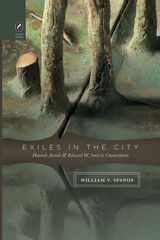 Exiles in the City: Hannah Arendt and Edward W. Said in Counterpoint
William V. Spanos
Ohio State University Press, 2012 Exiles in the City: Hannah Arendt and Edward W. Said in Counterpoint, by William V. Spanos, explores the affiliative relationship between Arendt’s and Said’s thought, not simply their mutual emphasis on the importance of the exilic consciousness in an age characterized by the decline of the nation-state and the rise of globalization, but also on the oppositional politics that a displaced consciousness enables. The pairing of these two extraordinary intellectuals is unusual and controversial because of their ethnic identities. In radically secularizing their comportment towards being, their exilic condition enabled them to undertake inaugural critiques of the culture of the nation-state system of Western modernity. As variations on the theme of exile, the five chapters of this book constitute reflections on what is foundational and abiding in both Arendt’s and Said’s work. They not only document the heretofore unnoticed affiliation between the two thinkers. They also shed light on Arendt’s and Said’s proleptic activist explorations of the urgent “question of Palestine,” especially on the fraught present situation, which bears increasing witness to the irony that the Israeli nation-state’s “solution” has, from the beginning, systematically repeated the degradations the Jewish people suffered at the hands of German nationalism.
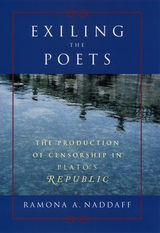 Exiling the Poets: The Production of Censorship in Plato's Republic
Ramona A. Naddaff
University of Chicago Press, 2002 The question of why Plato censored poetry in his Republic has bedeviled scholars for centuries. In Exiling the Poets, Ramona A. Naddaff offers a strikingly original interpretation of this ancient quarrel between poetry and philosophy. Underscoring not only the repressive but also the productive dimension of literary censorship, Naddaff brings to light Plato's fundamental ambivalence about the value of poetic discourse in philosophical investigation.
Censorship, Nadaff argues, is not merely a mechanism of silencing but also provokes new ways of speaking about controversial and crucial cultural and artistic events. It functions philosophically in the Republic to subvert Plato's most crucial arguments about politics, epistemology, metaphysics, and ethics. Naddaff develops this stunning argument through an extraordinary reading of Plato's work. In books 2 and 3, the first censorship of poetry, she finds that Plato constitutes the poet as a rival with whom the philosopher must vie agonistically. In other words, philosophy does not replace poetry, as most commentators have suggested; rather, the philosopher becomes a worthy and ultimately victorious poetic competitor. In book 10's second censorship, Plato exiles the poets as a mode of self-subversion, rethinking and revising his theory of mimesis, of the immortality of the soul, and, most important, the first censorship of poetry. Finally, in a subtle and sophisticated analysis of the myth of Er, Naddaff explains how Plato himself censors his own censorships of poetry, thus producing the unexpected result of a poetically animated and open-ended dialectical philosophy.
 Existential Cognition: Computational Minds in the World
Ron McClamrock
University of Chicago Press, 1995 While the notion of the mind as information-processor—a kind of computational system—is widely accepted, many scientists and philosophers have assumed that this account of cognition shows that the mind's operations are characterizable independent of their relationship to the external world. Existential Cognition challenges the internalist view of mind, arguing that intelligence, thought, and action cannot be understood in isolation, but only in interaction with the outside world.
Arguing that the mind is essentially embedded in the external world, Ron McClamrock provides a schema that allows cognitive scientists to address such long-standing problems in artificial intelligence as the "frame" problem and the issue of "bounded" rationality. Extending this schema to cover progress in other studies of behavior, including language, vision, and action, McClamrock reinterprets the importance of the organism/environment distinction. McClamrock also considers the broader philosophical question of the place of mind in the world, particularly with regard to questions of intentionality, subjectivity, and phenomenology.
With implications for philosophy, cognitive and computer science, AI, and psychology, this book synthesizes state-of-the-art work in philosophy and cognitive science on how the mind interacts with the world to produce thoughts, ideas, and actions.
Existential Ethics and the Philosophy of Historiography: Transgenerational Life and Memory in Literary Culture
Natan Elgabsi
Amsterdam University Press, 2026 -Expands the philosophy of history, and the aesthetics and politics of history and memory culture, in the direction of existential ethics. -Argues how personal responsibility when historicizing is to answer to absent others over generations as a relentless call on our existential selves. -Deals in fresh ways with narrative aesthetics, hermeneutics, and deconstruction in order to articulate ethical responsibility in literary activities.
The Existential Self in Society
Edited by Joseph A. Kotarba and Andrea Fontana
University of Chicago Press, 1984 The Existential Self in Society explores the ways in which we experience and shape our individuality in a rapidly changing social world. Kotarba and Fontana have gathered eleven original essays that form an exciting contribution and an ideal introduction to the emerging field of existential sociology.
The Exit Coach
Megan Staffel
Four Way Books, 2016 How do we find the courage to change? In The Exit Coach, a collection of six stories and a novella, the characters arrive at an impasse that requires them to step out of the wreckage of their habituated lives. It is the entrance of an unexpected voice—a visitor from France, a retired talent scout, an invisible friend, a midnight phone call, or even a wild animal—that disrupts their patterns of behavior and illuminates the possibilities they’ve been blind to, pointing the way to an exit they’ve dreamt of, but lacked the courage to enter.
 Exit Here for Fish!: Enjoying and Conserving New Jersey's Recreational Fisheries
Piehler, Glenn R
Rutgers University Press, 2000 Known as the Garden State, New Jersey could also be called the Fishing State. New Jersey boasts more than 6,000 miles of rivers and streams; 24,000 acres of public lakes, reservoirs and ponds; 420 square miles of open bay and estuary waters; and 120 miles of ocean coast — with nearly every gallon of water swimming with a remarkable variety of fish.
Using his more than 50 years of personal and academic observations, Glenn R. Piehler has written the perfect guidebook for new and proficient anglers, as well as students of fisheries science.
Piehler begins with the taxonomic origins and classification of almost 100 species of fresh and saltwater sport fishes described in the book, as well as “a number of creatures you might unwittingly hook into . . . with just enough technical jargon and information on the general biology of fishes to make the remaining chapters more winning,” he writes. “In each case I have tried to capture the essence of each species or group of species—what they look like, how big they get, where they came from, what kind of waterbodies they live in, what they do for a living, generally how and when they may be caught, how they’ve fared over the years and are doing today, and where you can get more specific information about some of them.”
Exit Here for Fish examines the factors affecting the distribution and abundance of fish, probing the controversies surrounding preservation efforts, and the apportionment of fish among sport and commercial interests. Piehler looks at the seldom-examined history of fisheries and laws dealing with their management, habitats, and water quality. Finally, he lists a host of activities readers can enjoy, such as fish tagging and volunteering for the Wildlife Conservation Corps, to help preserve and protect the fun of fishing.
 Exit of a Hero: Photography and the Visual Culture of Commemoration in Southern Nigeria
Okechukwu Nwafor
University of Michigan Press, 2026 In Exit of a Hero, Okechukwu Nwafor explores the cultural, political, and socio-economic implications of photography in commemorative practices in southern Nigeria from the nineteenth century to the present. Focusing on obituary and commemorative photographs of late nineteenth and early twentieth-century Lagos to contemporary funeral posters, booklets, and social media posts, Nwafor tracks the historical evolution of the iconic and heroic image. He argues that the quest to produce an ideal memorial body is not just a personal aesthetic choice but a deliberate photographic project that resonates with the Igbo aspirations for heroic achievement.
Exit of a Hero asserts that the visual canonization transforms the deceased from a fallible being to an unimpeachable character who transcends underachievement, imperfection, and failed social performance to emerge as a saintly icon of the Igbo public sphere. In seeking an alternative, hyper-visible public self, social media reclaims the lost hero image of the deceased, reconstituting the contested Igbo public space as a lived reality where heroes and icons are actively and eternally commemorated. Nwafor unveils the creative imaginations of colonial subjects and postcolonial citizens as memorialization has become entangled within the intersecting discursive spaces of print culture and the public sphere.
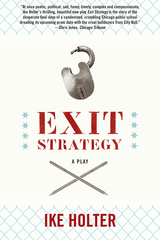 Exit Strategy: A Play
Ike Holter
Northwestern University Press, 2018 Righteously angry, riotously funny, and wise to the tensions between abstract policy and lived experience, Ike Holter's play Exit Strategy centers on vivid, unforgettable characters struggling to maintain faith in a vocation that is being determinedly undermined.
Drawing from the headlines, Exit Strategy is set in Chicago and tells the story of a fictional public high school slated for closure at the end of the year. Despite funding cuts, bureaucrats run amok, apathy, and a rodent infestation, a small, multiracial group of teachers launch a last-minute effort to save the school, and put their careers, futures, and safety in the hands of a fast-talking administrator who may be in over his head. The tenuous situation also raises fears and anxieties among students, and within the volcanic neighborhood that is home to the school.
Holter has said that Exit Strategy was inspired by the 2013 mass closure of forty-nine Chicago public schools, which displaced nearly 12,000 children—the majority of directly impacted students were African American and Latinx. Hailed as "riveting," "sharp," and "richly metaphoric" by critics, the play indicts how we educate our children in big American cities, and shows why gaps between haves and have-nots continue to grow.
Exit Strategy is one of seven plays in Ike Holter's cycle of works set in Chicago or Chicago-inspired neighborhoods.
 Exit Theater
Mike Lala
University Press of Colorado, 2016 Published by the Center for Literary Publishing at Colorado State University
Winner of the 2016 Colorado Prize for Poetry
Selected by Tyrone Williams for the 2016 Colorado Prize for Poetry, Exit Theater casts classical elegy, with dazzling formal innovation, into a staggering work of contemporary, political polyphony. Through monologues, performance scripts, and poems of exquisite prosody, Mike Lala examines the human figure—as subject and object, enemy and ally—in the context of a progressively defigured and hostile world. Catullus, Shakespeare, Cy Twombly, and Lydia Delectorskaya echo across engagements with Israeli generals, accused terrorists, State Department employees, nuclear scientists, Saturday Night Live actors, war criminals, malware, and a host of mythic, literary, and half-extant spectral characters. Amid the cacophony, Lala implicates every actor, including himself, in a web of shared culpability vis-à-vis consumerism, representation, speaking, writing, and making art against the backdrop of the endless, open wars of a post–Cold War, post-2001 era. Exit Theater is a debut of and against its time—a book about war, art, and what it means to make art in a time of war.
|
|
